Evaluation of the Search and Rescue Program: Canadian Coast Guard Auxiliary
Final Report
Project number 96743
March, 2022
Evaluation of the Search and Rescue Program: Canadian Coast Guard Auxiliary
(PDF, 1.3 KB)
Table of Contents
- 1.0 Evaluation context
- 2.0 Program profile and context
- 2.1 Overview of the Search and Rescue program
- 2.2 Search and rescue services in the context of changes to the Canadian Coast Guard
- 2.3 Overview of the Canadian Coast Guard Auxiliary
- 2.4 Canadian Coast Guard Auxiliary area of responsibility
- 2.5 Canadian Coast Guard Auxiliary resources
- 2.6 Ocean Protection Plan investments in marine safety and impact on the Canadian Coast Guard Auxiliary
- 3.0 Evaluation findings
- 3.1 Relevance
- 3.2 Resource utilization
- 3.3 Effectiveness
- 3.3.1 Preparedness of the Auxiliary to respond to maritime SAR incidents: membership, vessels and equipment
- 3.3.2 Preparedness of the Auxiliary to respond to maritime search and rescue incidents: training
- 3.3.3 Effectiveness in responding to maritime search and rescue incidents
- 3.3.4 Contribution of the Indigenous community boat volunteer program to maritime search and rescue
- 4.0 Conclusions and considerations
- 5.0 Appendices
- Footnotes
1.0 Evaluation context
1.1 Overview
This report presents the results of the Evaluation of the Search and Rescue Program (SAR): Canadian Coast Guard Auxiliary (CCGA). The evaluation was conducted by the Evaluation Division at Fisheries and Oceans Canada (DFO) and the Canadian Coast Guard (CCG) from March to November 2021.
The evaluation complies with the Treasury Board Policy on Results and meets the requirements of the Financial Administration Act.
1.2 Evaluation context, scope and objectives
The scope of the evaluation was established through a planning phase, which included consultations with program representatives. These consultations determined that the priority for the SAR program evaluation was the CCGA, given recent investments (for more on this, see the program profile and context). In addition, as per the Act, an evaluation of the CCGA was required to be completed by March 2022. The program was last evaluated in 2016-17 as part of the Evaluation of the Search and Rescue Services Program.
The evaluation included an assessment of the Auxiliary’s relevance, use of resources and effectiveness, as related to the CCGA activities funded through the contribution agreements, for the time period from 2016-17 to 2020-21.
1.3 Evaluation methodology and evaluation questions
The evaluation used multiple lines of evidence, including interviews, data analysis, document review, and a survey of auxiliary membersFootnote 1 to examine the questions presented below (see Appendix A for the detailed evaluation methodology). A case study of the Indigenous Community Boat Volunteer (ICBV) pilot program was conducted as part of the evaluation. Results from the case study are presented throughout the report and a detailed profile of the program is provided in Appendix B.
Evaluation Questions
Relevance
- Is the CCGA's current role appropriate as related to maritime response and are there other roles that the CCGA could fulfill?
Resource utilization
- To what extent does the CCG funding support the ability of CCGA to participate in maritime search and rescue?
- To what extent does the CCGA use the resources efficiently?
- What is the value-added of the CCG investment in the CCGA?
Effectiveness
- To what extent is the CCGA prepared to respond to SAR incidents?
- To what extent is the CCGA effective in responding to maritime incidents?
- To what extent has the Indigenous Community Boat Volunteer (ICBV) program increased the capacity of Indigenous communities to participate in the CCGA? To what extent has the program enhanced maritime response?
As the auxiliary organizations are separate legal entities from the Government of Canada and operate at arms-length from the CCG, an assessment of their management and administration was not included in the scope of the evaluation. The evaluation did, however, examine practices that are in place to ensure the efficient use of resources within the auxiliary organizations.
2.0 Program profile and context
2.1 Overview of the Search and Rescue program
The Canadian SAR system is a cooperative effort between federal, provincial, municipal and territorial governments, as well as volunteer organizations. It involves searching for and assisting people, ships, aircraft and other craft that are, or are believed to be, in imminent danger.
The CCG’s maritime SAR program leads, delivers and maintains preparedness for the 5.3 million square kilometre maritime component of the federal search and rescue system.
The SAR program supports the CCG in delivering its mandate related to response capacity to on-water incidents, increased Indigenous participation in Canada’s marine response system, and better co-management of Canada’s three oceans. This is accomplished with the support of stakeholders and partners, including the Canadian Armed Forces and the CCGA.
The SAR program’s main objective is to save 100% of lives at risk, and each year, the CCG responds to over 5,000 calls for marine assistance. The CCG’s on-water SAR assets include over 44 lifeboats stations, 27 inshore rescue boats, and a variety of primary SAR vessels.
Coordination for SAR is done through three joint rescue coordination centres (JRCC) and two maritime rescue sub-centres (MRSC). Alerting and communication services are coordinated with the CCG’s Marine Communications and Traffic Services program.
The SAR program is managed by the Response Directorate within CCG Operations and between 2016-17 and 2020-21 planned program expenditures totaled $235 million, which included $32.2 in grants and contributions for the CCGA.
The Canadian Coast Guard Auxiliary is a key component of the SAR system. A profile of the auxiliary and related operating context is provided in section 2.3.
2.2 Search and rescue services in the context of changes to the Canadian Coast Guard
Since 2015-16, the CCG received significant investments to enhance its ability to respond to maritime incidents and address gaps in capacity for SAR operations in priority areas, particularly in the Arctic, and to re-establish SAR assets previously closed on the West and East Coasts.
The launch of the Oceans Protection Plan (OPP), in 2017, provided funding to further strengthen SAR capacity and to reinstate national strategic coordination and guidance for the SAR program. At the same time, there were some organizational changes made within the CCG, including the creation of a new Arctic Region and a reorganization of National Headquarters.
Since 2017-18, the SAR program has been delivering on these increased expectations and responsibilities, while adjusting its resources and aligning with the business processes within the CCG’s Response Directorate.
2.3 Overview of the Canadian Coast Guard Auxiliary
The CCGA is a network of federally incorporated, non-profit volunteer organizations dedicated to search and rescue and safe boating activities. The CCGA is comprised of six regional organizations (see Figure 1 below) and one national organization, which are separate legal entities from the Government of Canada and work in close partnership with the CCG. Each auxiliary has a Board of Governors led by a President. The CCGA-National is responsible for governance and administration at the national level. It supports the CCGA National Council, which consists of the Presidents of the regional CCGAs.
The six CCGA regions operate in different marine, social and business environments, which create different contexts, risk factors, and challenges to address. Consequently, it is not possible to compare the regions when looking at the preparedness and effectiveness of the Auxiliary.
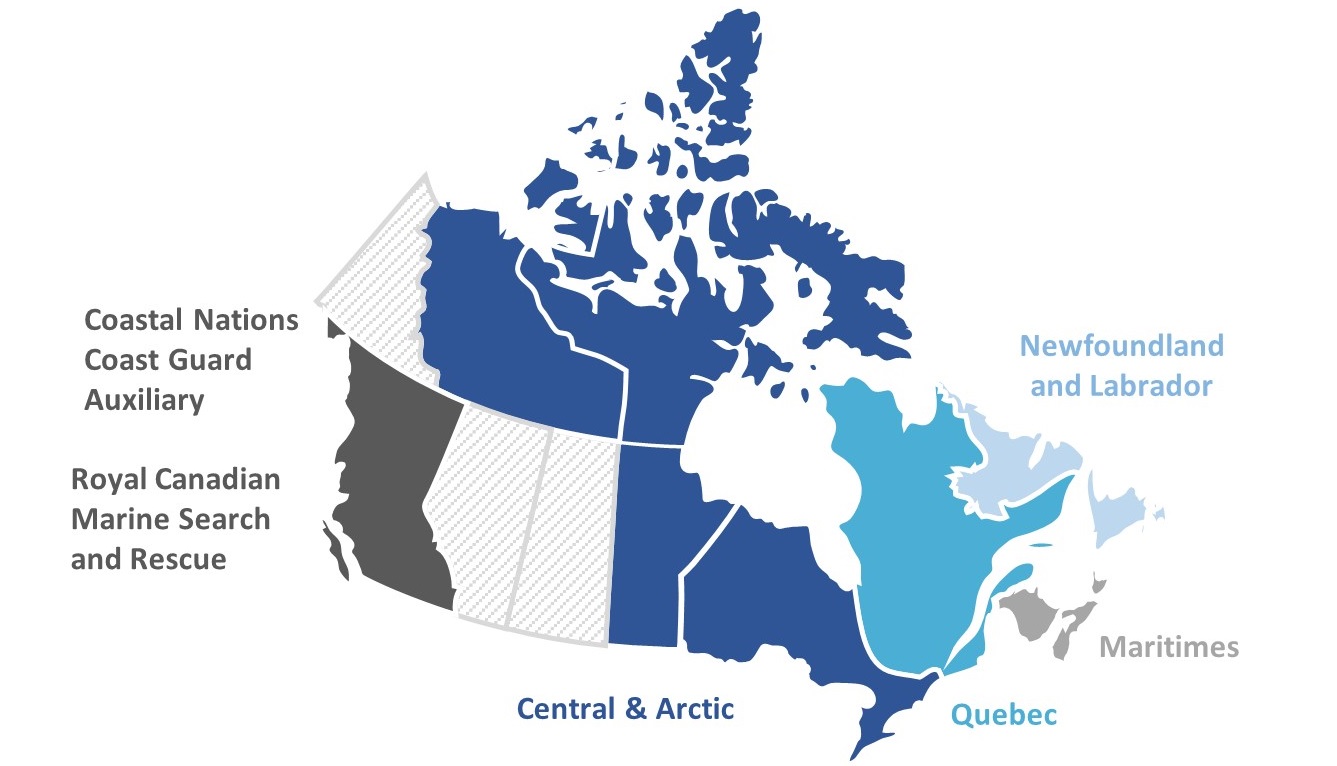
Description
A map of Canada showing the six regional organizations of the Canadian Coast Guard
- The Coastal Nations Coast Guard Auxiliary in British Columbia;
- The Royal Canadian Marine Search and Rescue in British Columbia;
- The Canadian Coast Guard Auxiliary in the Central and Arctic regions covering the two provinces of Ontario and Manitoba and two territories of Nunavut and Northwest territories;
- The Canadian Coast Guard Auxiliary in Quebec;
- The Canadian Coast Guard Auxiliary in the Maritimes region covering New Brunswick, Nova Scotia, Prince Edward Island and the Iles de la Madeleine; and
- The Canadian Coast Guard Auxiliary in Newfoundland and Labrador.
Royal Canadian Marine Search and Rescue (RCMSAR)Footnote 3:
Covers British Columbia (BC) with seven SAR areas. There is a regional headquarters and 32 stations, supported by 32 independent societies. Most vessels are owned by RCMSAR’s SAR stations. There is a reliance on fundraising for the acquisition of vessels, and on provincial funding to support a training institute with a comprehensive training program.
Coastal Nations Coast Guard Auxiliary (Coastal Nations)Footnote 4:
Established in 2018-19 and is Canada’s first Indigenous-led auxiliary. It is still in the implementation phase and building capacity (e.g., expanding presence, training, buying community vessels through the ICBV program). Currently, there are auxiliary units in 7 First Nations communities along the BC coast, two of which are operational.
Canadian Coast Guard Auxiliary – Central and Arctic (C&A):
Covers 2 provinces and 2 territories with 14 SAR areas. About 60% of vessels are private (commercial, recreational, pleasure boats) whose owners are auxiliary members. Volunteers from communities operate community vessels (20%) or CCGA-owned vessels (20%). The region has the greatest involvement with Arctic expansion and has participated in the ICBV program since 2016-17. Developed a regional 3-phase auxiliary training program, approved by Transport Canada.
Canadian Coast Guard Auxiliary – Quebec:
Covers Quebec, including 14 Nunavik communities with four SAR areas. About 80% of vessels are private (e.g., fishery, commercial, recreational) and 20% are dedicated SAR vessels owned by the CCGA or communities. Region has participated in the ICBV program since 2019- 2020. Adopted the C&A training program.
Canadian Coast Guard Auxiliary – Maritimes:
Covers three provinces (NB, NS, and PEI) and Iles de la Madeleine with six SAR areas. Members and vessels are predominantly from the commercial fishing industry (88%), with the remaining being pleasure boaters (12%). Region has participated in the ICBV program since 2019-20. Adopted the C&A training program.
Canadian Coast Guard Auxiliary – Newfoundland and Labrador (NL):
Covers NL with six SAR areas. Most members are commercial fishers with strict mandatory training above what is required by the CCGA. Most vessels are privately owned. Region has participated in the ICBV program and Arctic expansion since 2018-19.
2.4 Canadian Coast Guard Auxiliary area of responsibility
The CCG funds the CCGA to carry-out authorized activities on its behalf, in support of the CCG’s mandate for maritime search and rescue. The auxiliaries are tasked for maritime missions by one of the three JRCCsFootnote 5. An auxiliary unit may be tasked as a sole responder when there are no primary (e.g., CCG) resources better situated for timely reaction, usually for incidents in M3, M4, and M5 classFootnote 6. It also may be tasked to provide support as one of several responders, even in missions for distress incidents (M1 and M2 class), provided that the training, expertise, and operational capabilities (e.g., vessel, SAR equipment) of the unit are appropriate for the required operations. The decision on what actions to take, and by which responder, is made by the JRCC based on many factors (e.g., emergency level, weather conditions, location, timing, readiness of resources) and in compliance with strict operational protocols.
Upon receiving a call from a JRCC, auxiliary units use a Green-Amber-Red risk-assessment tool to decide whether they are ready to participate safely and effectively in a mission. The decision is based on factors such as weather and water conditions, vessel type and equipment, and qualification of crew members.
2.5 Canadian Coast Guard Auxiliary resources
As of 2020-21, the CCGA had 4,139 members and access to 964 vessels. Most CCGA members are commercial fishers and pleasure boaters who volunteer their time and vessels to assist the CCG SAR program. Other CCGA members are volunteers from local communities who crew dedicated response vessels 24 hours a day, seven days a week. In some areas, these vessels are owned by the auxiliary. In other areas, they are owned by communities that are enrolled in the auxiliary.
Between 2016-17 and 2020-21 the CCG provided $32.2 million in funding to the auxiliary–an average of $6.4 million per year. Most of this funding was core funding (80%), with the remainder being provided through OPP funding (for more on funding, see section 3.2.1).
2.6 Ocean Protection Plan investments in marine safety and impact on the Canadian Coast Guard Auxiliary
In November 2016, the federal government announced the five-year, $1.5 billion OPP with the objective of protecting Canada’s coasts and waterways while continuing to grow the economy. More specifically, the investment was made to improve marine safety and responsible shipping, to protect Canada’s marine environment, and to offer new possibilities for Indigenous and coastal communities.
Several SAR-specific initiatives were included in the plan, which allowed the CCG to enhance its SAR coordination and capacity while also increasing support to the CCGA. These investments added capacity to the CCGA by expanding its volunteer network, particularly in Indigenous communities.
Highlights of Oceans Protection Plan investments
- Implement a national risk-based analysis of maritime SAR delivery (RAMSARD).
- Enhance the CCG’s SAR coordination and response capacity (e.g., 15 new lifeboats and 7 new lifeboat stations, establish MRSC in NL, increase emergency tow capacity in BC, establish an Arctic inshore rescue boat station in Rankin Inlet).
- Increase capacity within Indigenous communities through the Indigenous Community Response Training Project in BC and the delivery of the ICBV pilot program.
- Support the expansion of the CCGA network through the establishment of the Coastal Nations Coast Guard Auxiliary in BC and increased funding for the Auxiliary’s Arctic chapter.
3.0 Evaluation findings
3.1 Relevance
3.1.1 Need for the Canadian Coast Guard Auxiliary
Findings: The CCGA plays an important role within the Canadian search and rescue system and fills a need with respect to maritime search and rescue by providing additional capacity on the water and by helping to improve service coverage.
Volunteers have long been assisting with maritime search and rescue. However, they were not formally recognized as volunteers until the early 1960s and it was not until 1978 that the first non-profit organization, the Canadian Marine Rescue Auxiliary, was formed. Since that time, the auxiliary has been filling a need with respect to maritime response and supporting the CCG’s mandate and legal obligations to respond to on-water incidents that involve risks to mariners and to fulfill these obligations in a cost-effective manner.
The evaluation found that the CCGA provides maritime SAR capability in areas where the CCG does not have resources. It also fills some of the gaps in high-traffic areas (e.g., Vancouver, St. Lawrence River, NL) and remote coastal regions (e.g., Northern BC and Quebec, Labrador coast, the Arctic). In addition, CCGA volunteers are often experienced mariners who are very familiar with their local environments, thus providing local knowledge to support operations.
The need for the CCGA’s participation in maritime response is also demonstrated by the number of hours of operations it delivers and the number of taskings it receives—either as a sole responder or as an additional supporter to primary SAR resources.
Historical data show that the number of taskings to which the CCGA responded fluctuated from year to year, but between 2000 and 2020, it responded to an average of 1,779 taskings annually (see Figure 2 below). In the recent five-year period (2015-16 to 2019-20), on average, the CCGA responded to 1605 taskings annually, which is 24% of the total maritime SAR taskings (for more on this see section 3.3.3).
Between 2015-16 to 2019-20, CCGA taskings followed a decreasing trend, which is consistent with the trend for all maritime SAR taskings. The recent OPP investments in maritime safety, which could have reduced the risks and potential incident situations, could explain this decreasing trend. It is important to note that risks, such as those related to climate change and increased maritime activity in the north, suggest that the need for CCGA’s ongoing participation in maritime response will continue.

Source: CCGA National Statistics and internal CCGA documentation.
Description
The figure illustrates a line graph portraying the number of maritime search and rescue tasking undertaken by the Canadian Coast Guard Auxiliary from 2000 to 2020
The number of taskings is as follows:
- 1,754 taskings for 2000
- 2,036 taskings for 2001
- 2,120 taskings for 2002
- 2,022 taskings for 2003
- 1,831 taskings for 2004
- 1,649 taskings for 2005
- 1,804 taskings for 2006
- 1,829 taskings for 2007
- 1,738 taskings for 2008
- 1,749 taskings for 2009
- 1,942 taskings for 2010
- 1,842 taskings for 2011
- 1,913 taskings for 2012
- 1,660 taskings for 2013
- 1,763 taskings for 2014
- 1,819 taskings for 2015
- 1,966 taskings for 2016
- 1,627 taskings for 2017
- 1,702 taskings for 2018
- 1,275 taskings for 2019
- 1,319 taskings for 2020
Between 2015-16 and 2019-20, the CCGA responded to 8,027 maritime SAR calls and delivered 17,000 hours of SAR operations.
3.1.2 Role of the Canadian Coast Guard Auxiliary
Current role of the Canadian Coast Guard Auxiliary
The mission and the role of the auxiliary is clearly defined in the contribution agreements that each organization has with the CCG, which is to “provide strategically located (as determined by the CCG in consultation with the CCGA), trained and qualified CCGA members and vessels that are prepared and available to support the CCG’s search and rescue activities and other CCG mandated activities”. Currently, eligible activities and the contribution funding to support these are directly linked to the maritime SAR mandate of the CCG. However, under OPP, efforts have been made in some regions to explore the feasibility of gradually expanding the role of the CCGA for basic environmental response.
An analysis of operational data showed that, between 2015-16 and 2019-20, 92% of the SAR taskings in which the CCGA was involved were in a maritime environment (i.e., M1 to M5 class), which is aligned with its defined role. The remaining missions in which the CCGA was involved were other, non-maritime SAR activities (e.g., humanitarian assistance).
Data from the CCGA member survey showed that, in addition to SAR activities, some members have been involved in other activities, particularly with respect to public education and outreach.
- 28% out of 873 CCGA member responders said they sometimes or often conduct public outreach and education
- 15% out of 871 CCGA member responders said they sometimes or often check wrecked or abandoned vessels
- 11% out of 867 CCGA member responders said they sometimes or often observe marine wildlife
- 8% out of 874 CCGA member responders said they sometimes or often check CCG aids to navigation
- 3% out of 875 CCGA member responders said they sometimes or often assess marine pollution spills
Note: Survey respondents were asked to indicate how often they participated in other activities using the scale: never, rarely (1 to 2 times per year), sometimes (3 to 5 times per year), or often (6 or more times per year).
Views on the future role of the Auxiliary
Some interviewees indicated that it would be reasonable to expand the CCGA’s role in the area of basic environmental response. To date, some CCGA members have had some marine pollution training, however, the auxiliary has not been formally tasked to conduct environmental response. It was stressed, however, that adding new activities would require changes to the current policy and legal framework under which the auxiliary operates, as well as additional training and funding. Furthermore, it was noted that not all regions would have the capacity to take on additional tasks at this time, and that not all members would be able to or willing to take on additional roles (e.g., commercial fishers).
3.2 Resource utilization
3.2.1 Funding for the Canadian Coast Guard Auxiliary
Findings: The Canadian Coast Guard provides grants and contributions funding to the Canadian Coast Guard Auxiliary for its operation. Since 2016-17, the core contribution funding provided to the Auxiliary has remained at approximately the same levels as 10-15 years ago. Some supplementary funding was provided to some regions to undertake activities funded through the Oceans Protection Plan. The Canadian Coast Guard is the main source of funds for the operation of the Auxiliary; although, some regions receive some funding from other sources.
Annual reporting requirements for the Auxiliary
Each auxiliary organization is required to provide the CCG with specific business and financial information related to the contribution funding, which is used by the CCG to manage the program and to ensure accountability and compliance with the Financial Administration Act. There are two key documents that are provided.
- An annual business plan is submitted at the beginning of each year and describes the priorities, challenges and authorized activities to be pursued, and the projected forecasts for the upcoming year.
- A financial report presents the expenses during the reporting period, broken down by eligibility categories and explains any variances from the annual business plan.
These two documents must be approved by the regional CCGA Board of Directors and by the regional CCG SAR superintendents. An overview of the total CCGA funding by eligibility category is provided in section 3.2.2.
Regional CCGA organizations must also share with the CCG:
- Annual insurance forms, required for the renewal of the national insurance policy; and
- External financial audit reports conducted annually at the regional level. These reports provide assurance that, overall, good financial management practices are followed in the regions as a result of applied internal controls.
Limitations with annual reporting
CCGA insurance forms are the only required source of statistical information for the CCG that provides complete and consistent information over the five-year period of the evaluation (e.g., number of members, enrolled vessels, assets) and they provide data at the regional level only. Other metrics reported in the insurance forms to determine insurance risks, are not linked to the eligibility categories and may not be reflective of the entire scope of activities and costs of the organization.
Similarly, the external financial audits are the most reliable source of information on other funding sources (beyond the CCG contribution) that are available to the CCG. Since the audits are at the level of the regional auxiliary, additional funding provided to stations operating as independent societies within the regional structure may not be captured.
FundingFootnote 7 provided to the Auxiliary by the Canadian Coast Guard
Between 2016-17 and 2020-21, the CCG provided $32.2M in funding to the Auxiliary, of which $25.9M was core funding and $6.3M was supplementary funding for OPP initiatives (e.g., Arctic Expansion, the ICBV program, and Arctic Auxiliary).
Overall, the supplementary funding represented 20% of the total CCG funding for the five-year period (see Figure 3 below). Supplementary funding was provided to five of the CCGA regions, except RCMSAR, to: create the new Coastal Nations region, create an Arctic Chapter (mostly to C&A region, and to a lesser extent to Quebec and NL regions), and support provided by the CCGA to the ICBV program. While there are expectations that some of the OPP funding may become part of the core CCGA funding in the next years, currently it is time-limited until 2022-23.
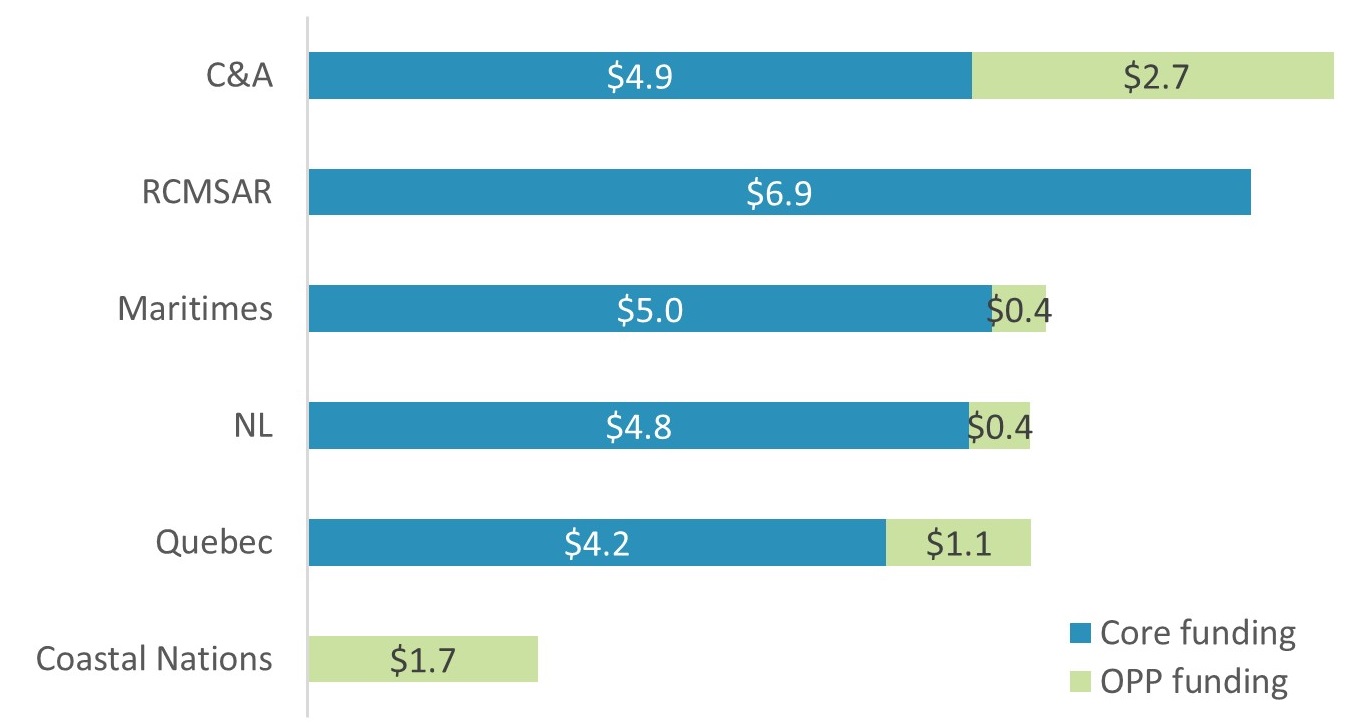
Source: CCGA annual business plans, 2016-17 to 2020-21.
Description
This figure contains a bar graph depicting the CCG core and OPP initiative funding in millions by CCGA region from the 2016-2017 fiscal year to the 2020-2021 fiscal year; over the five year period:
- The CCGA - Central and Arctic region received 4.9 million dollars in core funding and 2.7 million dollars in supplementary funding for OPP initiatives
- The RCMSAR received 6.9 million dollars in core funding and no supplementary funding for OPP initiatives
- The CCGA - Maritimes region received 5 million dollars in core funding and 0.4 million dollars in supplementary funding for OPP initiatives
- The CCGA - Newfoundland and Labrador region received 4.8 million dollars in core funding and 0.4 million dollars in supplementary funding for OPP initiatives
- The CCGA - Quebec region received 4.2 million dollars in core funding and 1.1 million dollars in supplementary funding for OPP initiatives
- The Coastal Nations Coast Guard Auxiliary received no core funding and 1.7 million dollars in supplementary funding for OPP initiatives
Challenges related to the core funding
As shown in Figure 4 below, there was almost no increase in the core funding for the CCGA nationally. The regional breakdown showed that, over the five years since 2016-17, four of the CCGA regions received around $1M core funding per year; thus, the annual core funding per region remained close to the average annual core funding received per region 10-15 years agoFootnote 8.
Some interviewees reiterated that costs have increased over time, thus, core funding does not cover all the costs that the auxiliaries incur, and this impacts the ability of the CCGA to maintain vessels, equipment, and training available and up to the standards set out in the CCGA National Guidelines and Competency Standards (for more on this see sections 3.3.1 and 3.3.2). While the overall CCGA funding has increased as a result of the OPP, the increase was linked to the specific additional activities already described. Therefore, it could not be used to offset negative impacts of factors that are out of Auxiliary’s control, such as inflation and rising costs (e.g., insurance, fuel, material).
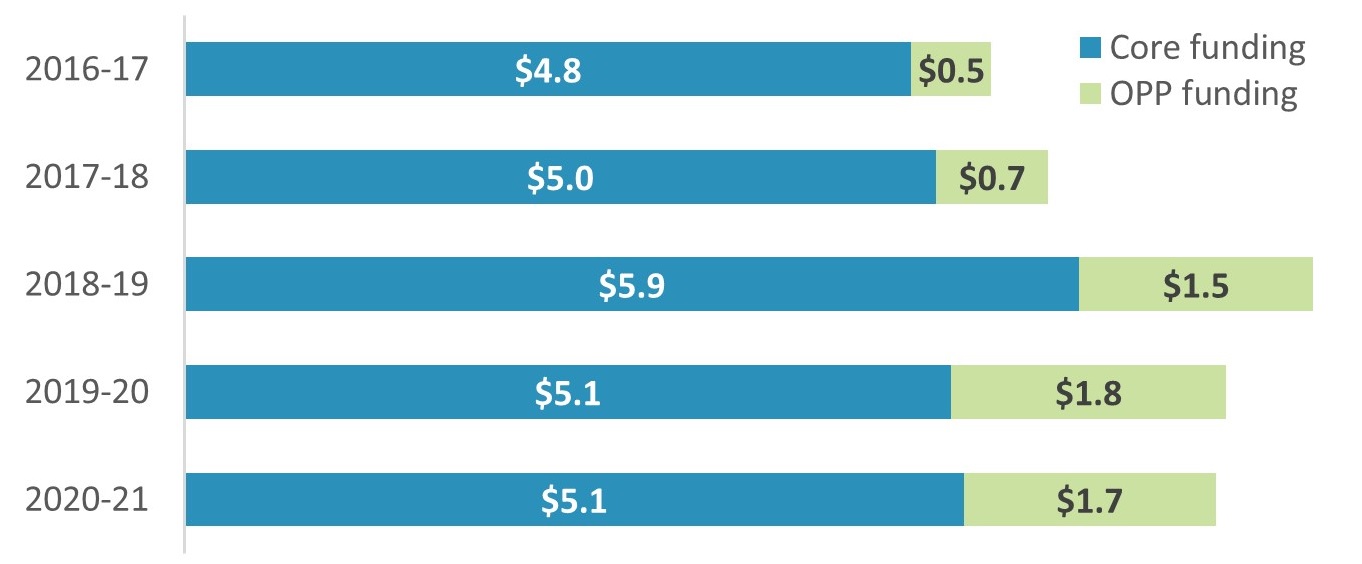
Source: CCGA annual business plans, 2016-17 to 2020-21.
Description
This figure contains a bar graph depicting the CCG core and OPP initiative funding in millions by fiscal year from the 2016-2017 fiscal year to the 2020-2021 fiscal year:
- In the 2016-2017 fiscal year 4.8 million dollars was allocated for core funding and 0.5 million dollars for supplementary funding for OPP initiatives
- In the 2017-2018 fiscal year 5 million dollars was allocated for core funding and 0.7 million dollars for supplementary funding for OPP initiatives
- In the 2018-2019 fiscal year 5.9 million dollars was allocated for core funding and 1.5 million dollars for supplementary funding for OPP initiatives
- In the 2019-2020 fiscal year 5.1 million dollars was allocated for core funding and 1.8 million dollars for supplementary funding for OPP initiatives
- In the 2020-2021 fiscal year 5.1 million dollars was allocated for core funding and 1.7 million dollars for supplementary funding for OPP initiatives
Sources of funding for the Canadian Coast Guard Auxiliary
Financial data from audit reports showed that CCG funding (core and supplementary) was the main source of funding for the CCGA, although there were some additional funding sources in some regions. Coastal Nations, Maritimes and C&A relied almost entirely on CCG funding, while RCMSAR and Quebec received the largest proportion of other funding, with 33% and 27% of their funding originating from other sources, respectively (see Figure 5 below). Other funding came from sources such as federal initiatives not led by the CCG, provincial funding, fundraising, or donations.
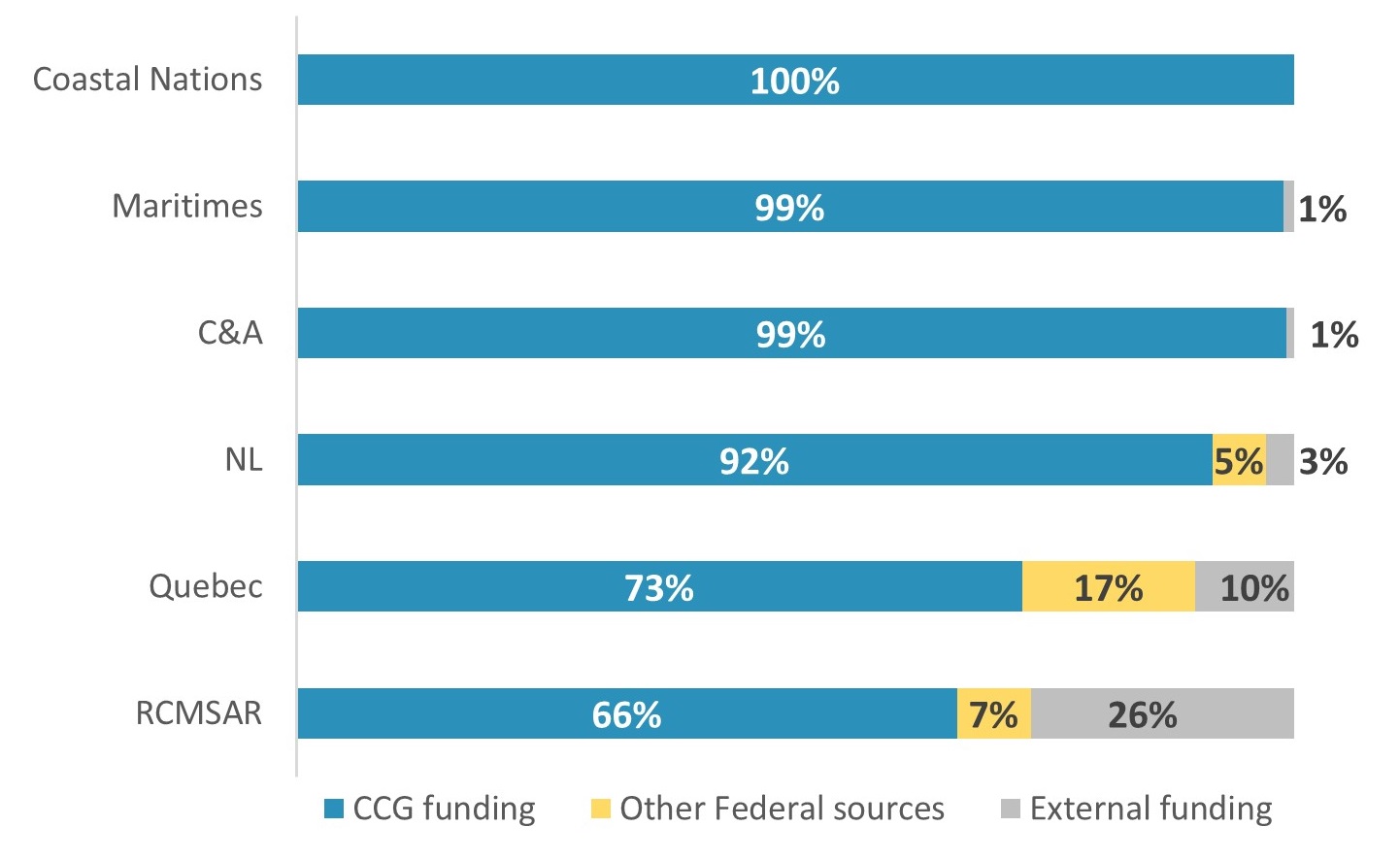
Source: CCGA annual audit reports, 2015-16 to 2019-20.
Description
This figure contains a bar graph depicting the distribution of funding sources as a percentage of total CCGA funding by CCGA region from the 2015-2016 fiscal year to the 2019-2020 fiscal year; over the five year period:
- The Coastal Nations Coast Guard Auxiliary sources of funding were 100% from CCG funding
- The CCGA - Maritimes’ sources of funding were 99% from CCG funding and 1% from external funding
- The CCGA - Central and Arctic region’s sources of funding were 99% from CCG funding and 1% from external funding
- The CCGA - Newfoundland and Labrador’s sources of funding were 92% from CCG funding, 5% from other Federal sources, and 3% from external funding
- The CCGA – Quebec’s sources of funding were 73% from CCG funding, 17% from other Federal sources, and 10% from external funding
- The RCMSAR‘s sources of funding were 66% from CCG funding, 7% from other Federal sources, and 26% from external funding
3.2.2 Utilization of the contribution funding by the Canadian Coast Guard Auxiliary
Findings: Overall, the Auxiliary uses over 50% of the total CCG funding for preparedness and capacity building. While the CCG obtains sufficient information for accountability and oversight of the contribution funding, there are data limitations to assessing the full costs for the Auxiliary to participate in the national SAR system.
Categories of eligible expenses
There are multiple categories for eligible expenses defined in the contribution agreements. For the purpose of the evaluation, they were regrouped in four categories:
- Support for SAR operations: costs for preparedness (e.g., maintenance of vessels and SAR equipment, member insurance premiums);
- Training: costs to support activities to ensure members have the competencies and skills required;
- SAR operations: costs incurred for participation in SAR taskings; and
- Administration: costs for business operations, including salary and professional services for managers and office staff.
Distribution of the CCG funding
Between 2016-17 and 2020-21, the Auxiliary allocated more than 50% of the total CCG funding ($32.2M) to support preparedness and capacity building (i.e., for support for SAR operations and training) and 37% of it was directed towards administration costs (see Figure 6 below). SAR operations represented a small percentage overall (12%) with small differences by region and by year, except in 2020-21 when it was the lowest (7%), likely as a result of the COVID-19 pandemic.
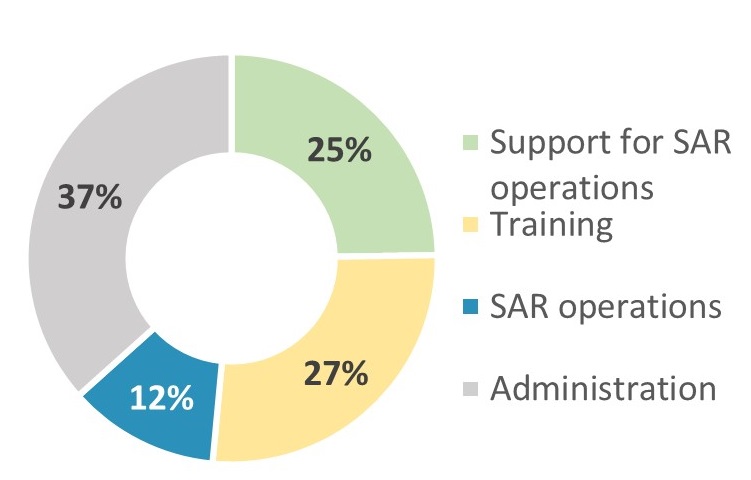
Source: CCGA annual business plans, 2016-17 to 2020-21.
Description
This figure contains a pie chart showing the distribution of contribution funding, by eligibility category from the 2016-2017 fiscal year to the 2020-2021 fiscal year. The distribution is as follows:
- 25% of contribution funding went towards support for SAR operations
- 27% of contribution funding went towards training
- 12% of contribution funding went towards SAR operations, and
- 37% of contribution funding went towards administration
Details about the funding by category in five regions (RCMSAR, C&A, Maritimes, Quebec and NL), for the period from 2016-17 to 2020-21Footnote 9, include:
- The preparedness and capacity building was the largest category of the regional budgets, varying in the range from 44% to 60%.
- Administration costs across the regions ranged from 28% to 44% of total costs. Since 2018-19, the budget for administration has increased, which helped to address existing shortages and supported increased activities undertaken as a result of OPP (e.g., support for the ICBV program).
The Coastal Nations region showed a different funding distribution due to its specific context. It was established in 2018-19, and for the three years of its existence the focus has been on setting up the organization and enrolling members. Thus, it had a higher percentage of funding allocated to administration (52%) and a relatively lower percentage allocated to training (12%).
Limitations to assess the full costs for the Auxiliary
The information provided by the CCGA to the CCG does not capture what it fully costs for each CCGA to sustain capacity and deliver SAR-related activities. For example, in some regions, there are auxiliary societies within their structure, which operate as separate non-profit entities and only part of their financial information is reported through the region. As noted, the CCGA is only required to share certain financial information and the provision of any additional information is at the discretion of each CCGA region. Without the full picture of funding sources and shortages, the CCG is limited in identifying shortages in service or capacity and in planning appropriate measures to address them.
3.2.3 Guidance, reporting and management practices
Finding: The CCG SAR program and the CCGA follow guidelines and standards, which are developed jointly, to support the administration and the delivery of the auxiliary program and to improve national consistency. Since 2016-17, there have been efforts to improve reporting tools and business practices. Internal guidance, management practices and controls vary across regions, and were found to be effective, although there are opportunities for improving communication and coordination.
Key guidance documents followed by CCGA
The contribution agreements between the CCG and the CCGA define the expectations, framework, planning and reporting requirements, and roles and responsibilities of the Auxiliary. Requirements are also outlined in two other guidance documents that were developed jointly by the CCG and the CCGA in 2017.
- The CCGA National Guidelines provide direction and assistance to members of the CCG and the CCGA with regards to the administration and delivery of the auxiliary program.
- The CCGA National Competency Standards define the minimum standards to be met or exceeded by each CCGA regional association within their existing internal training programs, certification and recertification requirements. The document is intended to ensure consistency at the national level without creating additional costs for the regions.
Improvements to business processes and tools
Overall, the regional CCGA organizations fulfill the reporting requirements from the contribution agreements. Prior to 2017-18, the regional CCGAs used different formats and tools for planning and reporting. Starting in 2018-19, the CCG has taken steps to better support tracking and management oversight.
- The CCG developed a CCGA Business Requirements Guide and a standardized financial template. This resulted in better reporting and more consistent and complete information, to the national management team at the CCG.
- It was challenging for the CCGA to adjust to all the changes in the processes, templates and approval requirements. To streamline reporting and address challenges, tools are continually reviewed at annual best practices meetings, where the CCGA provides feedback and suggestions to the CCG.
- Starting in 2019-20, the CCG is piloting the practice of conducting rotating recipient audits, to increase compliance assurance with the contribution agreements. These audits are conducted by external contractors, to supplement the current Auxiliary internal controls (e.g., ensuring there are no gaps in oversight, detecting errors, management override and/or inappropriate transactions or activities). The lessons learned from the pilot audit in C&A region are being used for the first cycle of audits, which will be selected based on identified potential risks.
Regional examples of good practices
All regional CCGA organizations have internal governance, guidance and management practices in place, and overall, are committed to improvements to become more efficient. For example, they use conference calls and e-mail as much as possible to minimize the costs of face-to-face meetings, coordinate the agendas for training and meetings to optimize expenses in both categories, implement regionally-developed financial management policies and a boat management policy for each unit, and establish standing committees on finances and governance to monitor spending and compliance with policies.
Collaboration between the CCG and the CCGA
Since the recent reorganization of the CCG in 2019, the CCGA program is managed within the broader area of incident response. Aspects such as administration, business management, renewal of the contribution agreements with CCGA and the related planning and reporting are carried-out by the CCG Response Services Team. The SAR national manager and the regional SAR superintendents are the subject matter experts for SAR operations. They meet on a regular basis to discuss and coordinate SAR matters within the CCG. At the regional level, there is ongoing collaboration between the SAR superintendents and the regional CCGA representatives. CCG-NHQ engages with auxiliaries at quarterly national meetings and through the planning and reporting process.
Communication and collaboration as areas of improvement
Interviewees and directors who responded to the CCGA member survey agreed that communication and collaboration within the CCGA, as well as between the CCG and the CCGA, could be improved. Some considerations include:
- Regions operate differently; thus, at some point, standardization becomes too restrictive. A more collaborative approach and open dialogue are needed to balance different operating realities.
- CCGA-National could play a greater role by facilitating a collaborative process toward resolving challenges and sharing best practices.
- Site visits from the CCG-NHQ staff to the CCGA regions would benefit mutual understanding and would facilitate collaboration.
- Communications with other emergency services and the JRCC/MRSC is sometimes a challenge.
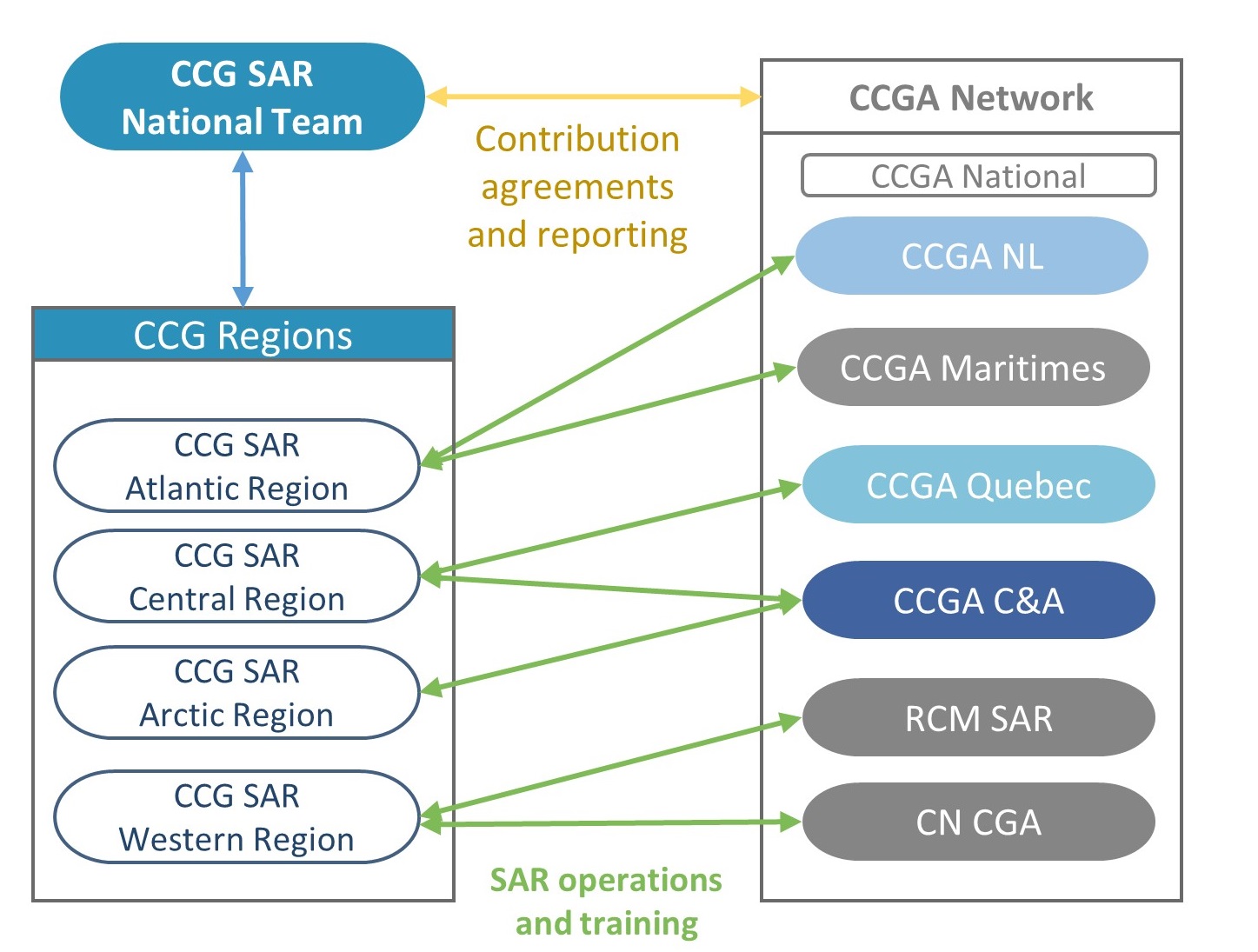
Description
This figure illustrates the CCG SAR program and CCG Auxiliary partnership network and lines of communication.
With regards to contribution agreements, there is bilateral collaboration and communication between the CCG SAR national team and the CCGA regional business management, indicated in the figure by an arrow between the two.
A set of arrows show collaboration between the CCG and the auxiliaries with regards to SAR operations and training. At the regional level, the collaboration and communication exist between:
- The CCG regional SAR superintendents for the Atlantic Region and both the CCGA Newfoundland and Labrador and the CCGA Maritimes.
- The CCG regional SAR superintendents for the Central Region and both the CCGA Central and Arctic and the CCGA Quebec.
- The CCG regional SAR superintendents for the Arctic Region and both the CCGA Central and Arctic.
- The CCG regional SAR superintendents for the Western Region and both the RCMSAR and the Coastal Nations Coast Guard Auxiliary.
An additional arrow indicates that the CCG-NHQ SAR national team and the CCG regional SAR superintendents meet on a regular basis to discuss and coordinate SAR matters within the CCG.
With regards to contribution agreements, there is bilateral collaboration and communication between the CCG-NHQ SAR national team and the CCGA regional business management. There are also quarterly meetings of all CCGA regions and the CCG national team.
With regards to SAR operations and training, the collaboration and communication is mostly at the regional level—and mostly between the CCG regional SAR superintendents and the CCGA regional training and operations officers; but also, with the respective JRCC or other SAR partners in the region.
3.3 Effectiveness
3.3.1 Preparedness of the Auxiliary to respond to maritime SAR incidents: membership, vessels and equipment
Findings: Overall, Canadian Coast Guard Auxiliary members were positive about their experience in the Auxiliary and feel well-prepared to respond to maritime SAR incidents as measured by the availability of members, vessels and equipment. There are existing challenges that can have an impact on the ability of the CCGA to respond to maritime SAR incidents, including declining membership and vessels and ensuring equipment meets standards.
Three aspects of the CCGA were examined to understand the extent to which it is prepared to respond to maritime SAR incidents: number of members, availability of vessels, and availability of equipment that meets standards.
Overall, members who responded to the CCGA member survey were very positive about their experience with the Auxiliary and are proud to be members. The survey showed that, 90% (793 of 881) of members and 88% (118 of 134) of directors who responded to the survey agreed or strongly agreed that they or their units are well-prepared to respond to maritime search and rescue incidents. The following sections detail the different aspects of preparedness and related challenges.
Canadian Coast Guard Auxiliary membership and vessels
Between 2016 and 2020, the CCGA had an average of 4,163 members each year. The number of members per region varies, with Coastal Nations having the smallest membership with 60 members and RCMSAR having the largest membership with 951 members, as of 2020 (see Figure 8 below). The differences in membership across the regions are due to how long the regions have been part of the auxiliary, as well as the different contexts within which each region operates (e.g., geography, marine environment).
In this same time period, the CCGA had an average of 995 registered vessels available and, similar to membership levels, the number of vessels in each region varies greatly, with Coastal Nations having the smallest fleet with 10 vessels and Maritimes and NL regions having the largest fleets with 366 and 361 vessels, respectively. The regional differences in the number of CCGA-registered vessels are reflective of the different ownership models. For example, in the Arctic and for Coastal Nations, all vessels are owned by communities, most of which were acquired with support from the ICBV program, while in the Maritimes and NL regions, vessels are privately owned.
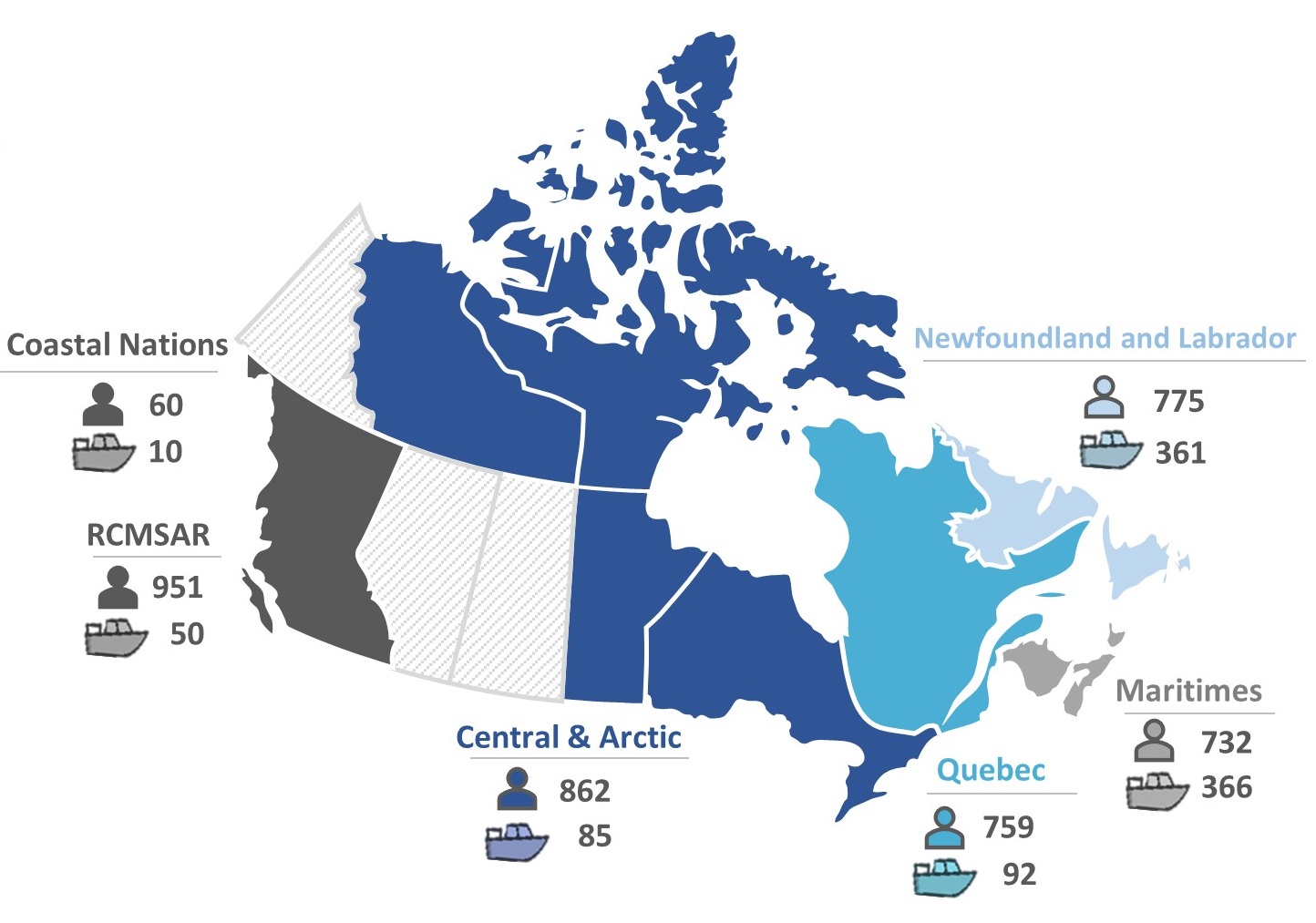
Source: CCGA National Statistics and internal CCGA documentation.
Description
This figure contains the map of Canada showcasing the number of CCGA members and vessels, by region as of 2020
- The Coastal Nations Coast Guard Auxiliary had 60 members and 10 vessels
- The Royal Canadian Marine Search and Rescue had 951 members and 50 vessels
- The Canadian Coast Guard Auxiliary - Central & Arctic had 862 members and 85 vessels
- The Canadian Coast Guard Auxiliary - Quebec had 759 members and 92 vessels
- The Canadian Coast Guard Auxiliary - Maritimes had 732 members and 366 vessels
- The Canadian Coast Guard Auxiliary - Newfoundland and Labrador had 775 members and 361 vessels
As of 2021, 33 new SAR vessels across five CCGA regions were funded through the ICBV program, most of which were for the Arctic. These vessels are to provide enhanced SAR capacity in Indigenous communities.
Trend in the number of CCGA members and vessels
Administrative data showed that there has been a decreasing trend in the number of CCGA members since 2000. Membership peaked in 2002 at 4,988; however, had declined to 4,139 by 2020—a decrease of 17% (see Figure 9 below).
Similarly, the number of registered CCGA vessels has been decreasing, but at a higher rate than membership. In 2000, there were 1,592 vessels registered to the CCGA; however, this decreased to 964 by 2020—a decrease of 39%. The decrease in the number of members and registered vessels is likely attributable to more members retiring with their vessels than new members being recruited. Survey respondents noted the ageing of CCGA's volunteers as a risk factor for availability of members, particularly in the Maritimes and NL regions.

Source: CCGA National Statistics and internal CCGA documentation.
Description
This figure depicts the CCGA membership and vessels for the period 2000-2020.
The number of CCGA members and vessels is as follows:
- in 2000, 4,523 CCGA members, 1,592 vessels
- in 2001, 4,666 CCGA members, 1,437 vessels
- in 2002, 4,988 CCGA members, 1,410 vessels
- in 2003, 4,734 CCGA members, 1,289 vessels
- in 2004, 4,704 CCGA members, 1,339 vessels
- in 2005, 4,502 CCGA members, 1,295 vessels
- in 2006, 4,266 CCGA members, 1,209 vessels
- in 2007, 4,261 CCGA members, 1,199 vessels
- in 2008, 4,194 CCGA members, 1,165 vessels
- in 2009, 4,007 CCGA members, 1,166 vessels
- in 2010, 3,979 CCGA members, 1,133 vessels
- in 2011, 4,091 CCGA members, 1,128 vessels
- in 2012, 4,002 CCGA members, 1,106 vessels
- in 2013, 3,989 CCGA members, 1,088 vessels
- in 2014, 3,964 CCGA members, 1,083 vessels
- in 2015, 4,054 CCGA members, 1,081 vessels
- in 2016, 4,217 CCGA members, 1006 vessels
- in 2017, 4,112 CCGA members, 1,015 vessels
- in 2018, 4,127 CCGA members, 998 vessels
- in 2019, 4,222 CCGA members, 991 vessels
- in 2020, 4,139 CCGA members, 964 vessels
Sufficiency of CCGA members and vessels
While 67% (88 of 132) of directors who responded to the survey agreed that there are enough members in their area to respond to SAR incidents, 18% (22 of 132) did not agree (see Figure 10 below). There are some slight regional variations, with RCMSAR being most in agreement that they have enough members (74% or 20 of 27) and Quebec being the least in agreement (61% or 17 of 28).
Similarly, 71% (94 of 132) of directors who responded to the agreed that there are enough vessels in their area to respond to SAR incidents; however, 18% (22 of 132) did not agree. There are some large regional variations, with virtually all RCMSAR directors who responded to the survey (93%, or 34 of 38) agreeing or strongly agreeing that they have enough vessels in their area. While Quebec region directors who responded to the survey were the least in agreement that there were enough vessels in their area (36%, or 10 of 28 somewhat or strongly disagreed).
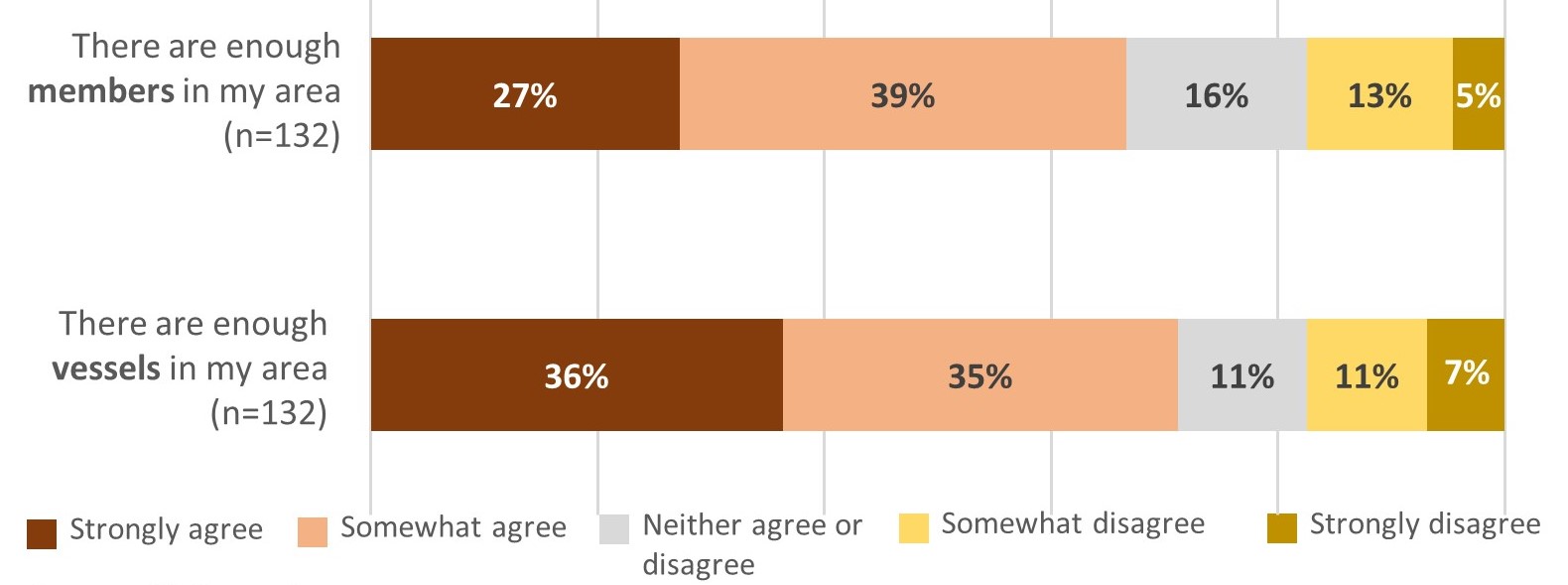
Source: CCGA member survey.
Description
The stacked bar graph depicts the percentage of CCGA director survey respondents who agreed or disagreed that they have enough members and vessels in their area.
In response to the statement, “There are enough members in my area (n=132)”, 27% of CCGA director survey respondents strongly agreed, 39% somewhat agreed, 16% neither agreed nor disagreed, 13% somewhat disagreed and 5% strongly disagreed.
In response to the statement, “There are enough vessels in my area (n=132)”, 36% of CCGA director survey respondents strongly agreed, 35% somewhat agreed, 11% neither agreed nor disagreed, 11% somewhat disagreed and 7% strongly disagreed.
Challenges related to membership
Directors who responded to the survey noted that having enough members is one of the biggest challenges they face (see Figure 11 below), which suggests that the decreasing trend in the number of members is likely to continue.
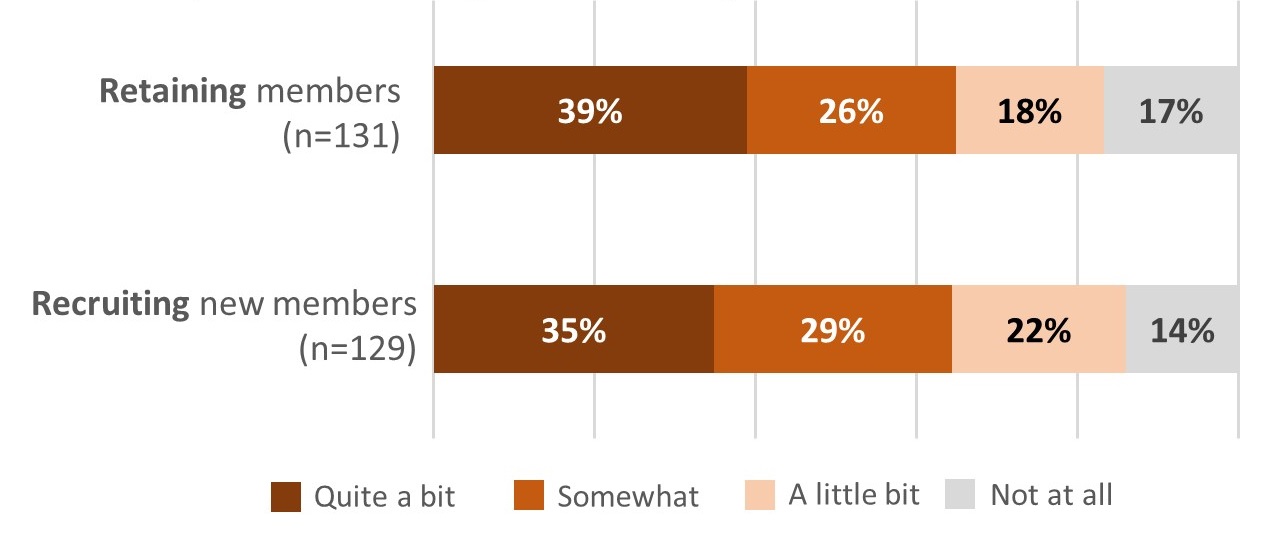
Source: CCGA member survey.
Description
The stacked bar graph depicts the views of CCGA director survey respondents on the level of difficulty with recruiting and retaining members.
In response to the question: ”How much of a challenge is retaining members in your area?” (n=131), 39% of CCGA director survey respondents answered “quite a bit”, 26% said “somewhat”, 18% answered a little bit” and 17% said “not at all”.
In response to the question: ”How much of a challenge is recruiting new members in your area?” (n=129), 35% of CCGA director survey respondents answered “quite a bit”, 29% said “somewhat”, 22% answered a little bit” and 14% said “not at all”.
These challenges differ by region, with Quebec noting the greatest challenges with retaining and recruiting members and Maritimes and NL regions indicating that retaining members is not really a challenge.
Barriers to becoming a member of the Auxiliary
Interviewees and survey respondents indicated that there are some barriers to being a member of the auxiliary.
- Remoteness: This is particularly related to the Arctic; though the proximity to a station could be a barrier in other geographic regions as well.
- Cultural differences: Cultural and language differences can present challenges for training and participation and can be a barrier for the participation of Indigenous communities.
- Income: In some areas, people cannot afford to join the Auxiliary and respond to missions due to the impact on their ability to support their families, or to absorb any personal costs for training or equipment.
Requirements for SAR equipment and vessel readiness
To respond to maritime SAR incidents, CCGA regions need vessels and equipment that meet the criteria outlined in the CCGA National Guidelines. Each vessel must meet all applicable regulatory requirements, have up to date Transport Canada Marine Safety Inspection certificates, and have the necessary SAR equipment and personal protective equipment on board. Requirements for equipment, vessels and maintenance, which are specific to each CCGA region and are approved by the CCG, must also be met.
Eligible and non-eligible costs related to vessels and equipment
CCGA contribution agreements clearly define which vessel and equipment costs are eligible or not for reimbursement. For vessels, eligible costs are inspection and registration fees and minor uninsured repairs that are incurred in SAR operations. The ongoing operation and maintenance costs for any auxiliary-owned vessel and its equipment, as well as capital costs over $10K, are not eligible. Some supplies, equipment and maintenance are part of eligible costs (e.g., safety supplies and equipment, SAR specific personal and vessel equipment, telecommunication equipment). However, other equipment-related costs are not eligible (e.g., purchase of auxiliary vessel; advanced technology devices such as Garmin trackers, maritime thermal cameras, or personal locator beacons).
Limitations related to data on equipment and vessel readiness
The evaluation had limited administrative data to assess the extent to which vessels and equipment are compliant with established requirements and standards, as this data is not reported to the CCG. Financial data was reflective of the reimbursed eligible expenses only, as non-eligible expenses are covered by the CCGA with surplus or external funding; or are paid by members and are not reported in the financial statements. While CCGA business plans provided some examples of funding pressures in some regions, a full picture of the vessels and equipment readiness and related shortages was not possible to develop. Consequently, the assessment of equipment and vessel readiness is based predominantly on survey data.
Availability and readiness of SAR vessels and equipment
Overall, most CCGA members who responded to the survey (86%, or 755 of 878) agreed that they have the equipment they need. One notable exception is CCGA Quebec, where 19% (26 of 140) disagreed.
Furthermore, 74% of CCGA members (646 of 873) said it is easy to keep their equipment in good working order. Of note, NL and Maritimes regions agreed more strongly on this and RCMSAR and Quebec regions disagreed more strongly (see Figure 12 below). This is consistent with the service delivery models in those regions (i.e., commercial fishers in NL and Maritimes regions maintain their own vessels for their work).
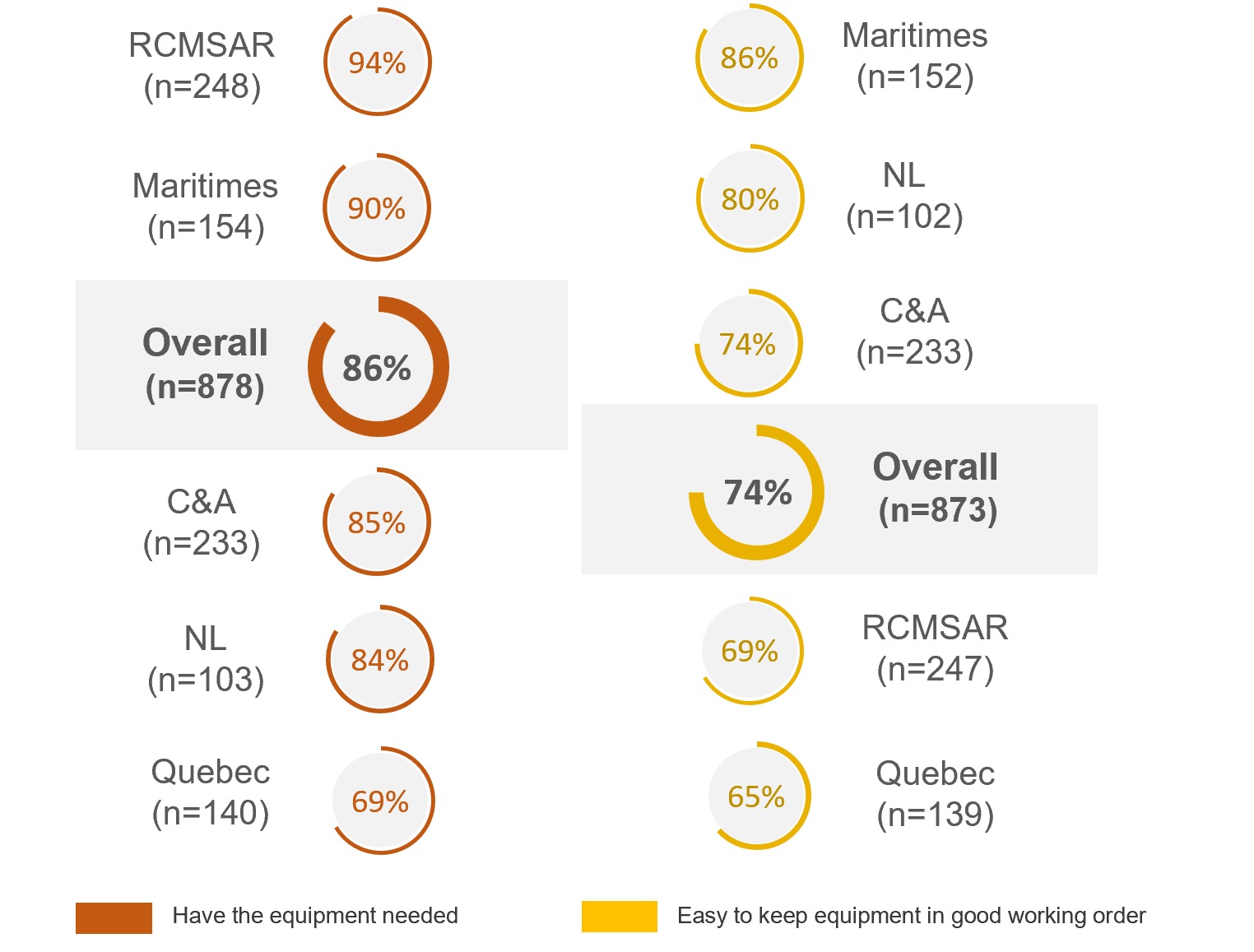
Source: CCGA member survey.
Description
The figure depicts the percentage of CCGA member survey respondents who agreed that they have the equipment needed and that it is easy to keep equipment in good working order.
In response to the statement, “I have the equipment that I need to respond to maritime search and rescue incidents”, overall, 86% of CCGA member survey respondents said that they have the equipment needed. The regional breakdown is as follows: 94% of RCMSAR members, 90% for Maritimes, 85% for Central and Arctic, 84% for Newfoundland and Labrador, and 69% for Quebec.
In response to the statement, “It is easy to keep the search and rescue equipment in good working order”, overall, 74% of CCGA member survey respondents said that it is easy to keep equipment in good working order. The regional breakdown is as follows: 86% for Maritimes, 80% for Newfoundland and Labrador, 74% for Central and Arctic, 69% for RCMSAR, and 65% for Quebec.
Challenges related to SAR vessels and equipment
The majority of CCGA directors who responded to the survey also agreed that members in their area have the equipment that is needed 74% (98 of 132)—slightly less agreement than their members. There are some notable regional differences, with only 50% (14 of 28) of CCGA directors in Quebec sharing this opinion.
While just over 80% of CCGA directors who responded to the survey agreed that SAR equipment used by members in their area complies with established standards, there are some regional differences, with Quebec Directors being less in agreement with this (see Figure 13 below).
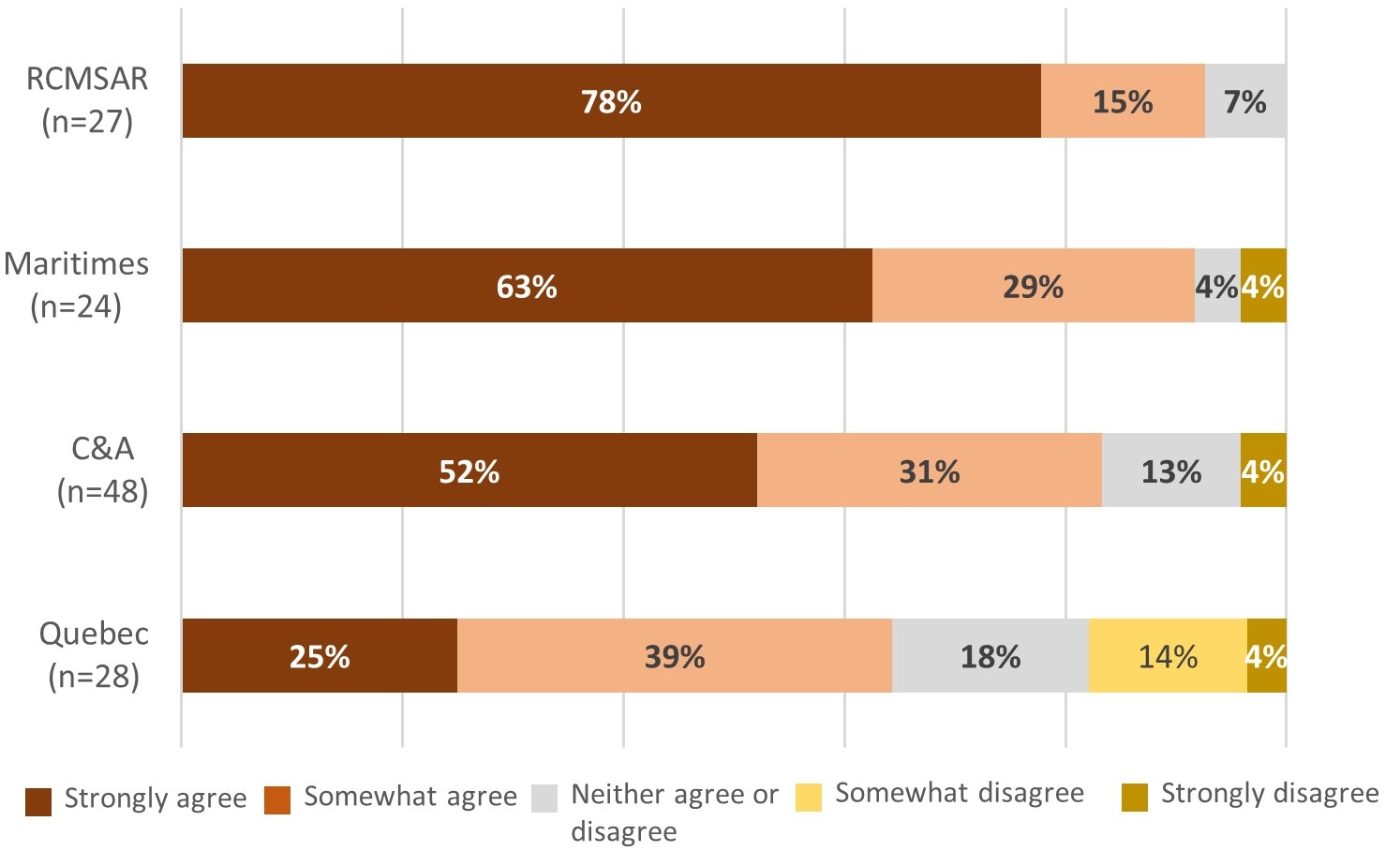
Source: CCGA member survey.
Description
The stacked bar graph depicts the level of agreement of CCGA director survey respondents regarding whether SAR equipment in their area complies with established standards.
In response to the statement, “Search and rescue equipment used by members in my area complies with established standards”:
- For RCMSAR (n=27), 78% of CCGA director survey respondents strongly agreed, 15% somewhat agreed, and 7% neither agreed nor disagreed.
- For Maritimes (n=24), 63% of CCGA director survey respondents strongly agreed, 29% somewhat agreed, 4% neither agreed nor disagreed, and 4% strongly disagreed.
- For Central and Arctic (n=48), 52% of CCGA director survey respondents strongly agreed, 31% somewhat agreed, 13% neither agreed nor disagreed, and 4% strongly disagreed.
- For Quebec (n=28), 25% of CCGA director survey respondents strongly agreed, 39% somewhat agreed, 18% neither agreed nor disagreed, 14% somewhat disagreed and 4% strongly disagreed.
Note: the regional breakdown is not provided for NL region due to the small number of respondents.
Ensuring that vessels are fit for service and that members have the equipment that is needed were identified as large challenges by the CCGA directors who responded to the survey (see Figure 14 below).
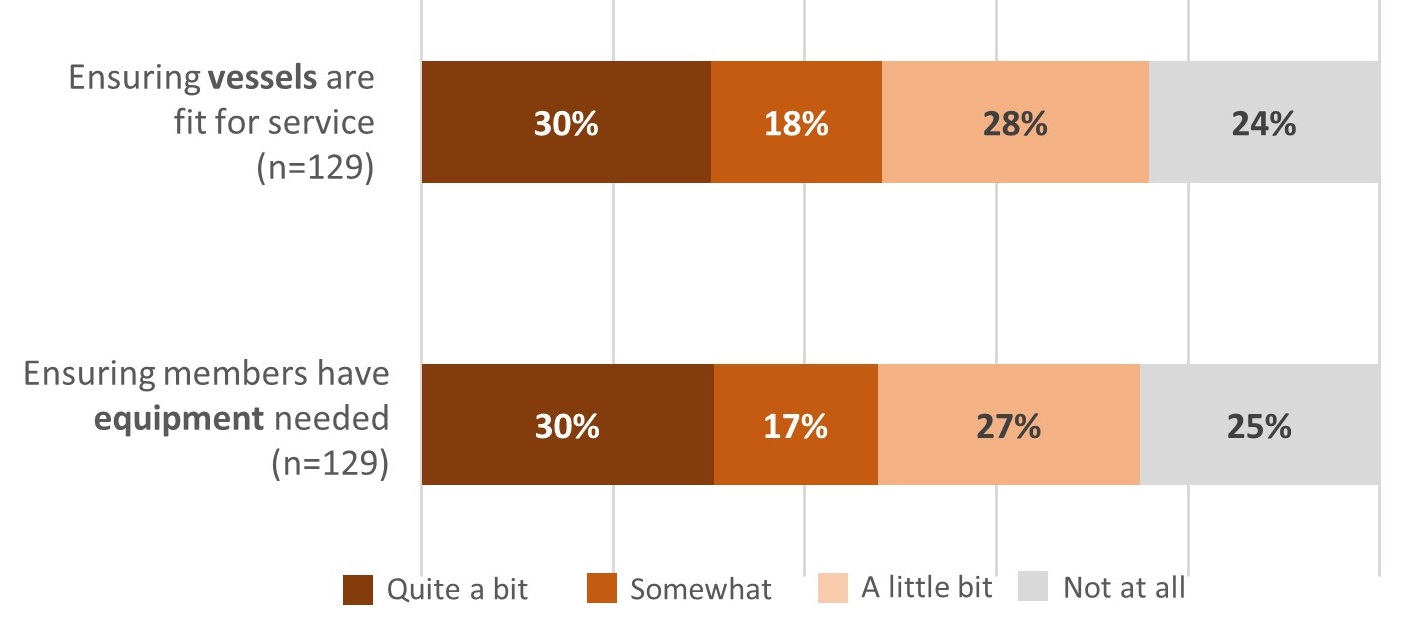
Source: CCGA member survey.
Description
The bar graph depicts the views of CCGA director survey respondents on the level of difficulty with ensuring vessels are fit for service and members have the equipment needed.
In response to the question: ”How much of a challenge is ensuring vessels are fit for service in your area?” (n=129), 30% of CCGA director survey respondents answered “quite a bit”, 18% said “somewhat”, 28% answered a little bit” and 24% said “not at all”.
In response to the question: ”How much of a challenge is ensuring members have the equipment needed in your area?” (n=129), 30% of CCGA director survey respondents answered “quite a bit”, 17% said “somewhat”, 27% answered a little bit” and 25% said “not at all”.
Similarly, interviewees noted that ensuring the readiness of vessels and SAR equipment was challenging.
- The CCG funding does not allow for the updating of tools and equipment. The lack of flexibility in the CCG’s grants and contribution framework can have an impact on the ability of the CCGA to respond as they are not funded for equipment.
- The advancements in maritime technology (e.g., fishing vessels) and equipment (e.g., communication devices and networks) result in increased costs for equipment to CCGA volunteers, which can exceed reimbursement rates and insurance coverage rate.
3.3.2 Preparedness of the Auxiliary to respond to maritime search and rescue incidents: training
Findings: CCGA regions consider it a key priority to train and support their members to meet competency standards and progress beyond the basic requirements. The CCGA member survey showed that training is available, accessible and useful; however, there are challenges related to internal and external factors, which have an impact on the delivery of training.
The regional auxiliary organizations are responsible for ensuring that their members have the necessary qualifications, credentials and practical skills to participate in maritime SAR missions. The CCG provides guidance, direction and training support to the regions.
Training requirements for Auxiliary members
Auxiliary members are required to have the qualifications and competencies to safely and competently participate in SAR missions. The basic training requirements and certification standards for CCGA members are defined in the 2017 National Competency Standards and are consistent with Transport Canada regulations. Initial perquisite requirements to become a member are the pleasure craft operator card, a restricted radio operator certificate, and a first aid course.
In addition, members must complete SAR operations training, usually provided by the CCGA in conjunction with the CCG, which may consist of courses such as small vessel operator proficiency, rigid hull inflatable operator training, mobile facilities and on-scene coordinator, and marine emergency duty. Coxswains and auxiliary unit leads take additional leadership training.
Training support for Auxiliary members
All CCGA organizations prioritize training for their members, they invest about one-quarter of their contribution funding in training. The training and related funding allocations are customized based on regional characteristics, for example:
- C&A implements its own three-phase training program, which has been adopted, with some adjustments, in the Quebec and Maritimes regions.
- RCMSAR offers, in their training center, a comprehensive training program, including training simulations. Most funding for the training center is provided by the province of BC.
- Some regions offer non-operational training in support of the business of the organizations (e.g., Quebec) and training for Board members and unit leaders (e.g., Quebec, Coastal Nations).
- Other initiatives also contribute to maintaining members’ skills and qualifications (e.g., the Green-Amber-Red operational risk-assessment tool, station-based personal protective equipment competency test for annual self-check of equipment).
Some regions implement alternative training formats to increase access to training, especially in remote communities and the Arctic. For example, some courses are offered through distance learning, and Train-the-Trainer and Arctic Instructor courses support the delivery of training on-site in communities, thus, reducing travel and reallocation challenges.
The role of CCG with regards to training
Regional specific factors (e.g., training capacity, geographic distribution of units, prior maritime training and experience of members) determine the training strategy of each CCGA region. These strategies are developed by the CCGA regions in conjunction with the CCG, in line with other relevant CCG training standards, and are approved by the regional CCG SAR superintendents. The CCG leads SAR exercises several times a year, where the Auxiliary and other partners can practice SAR search patterns or coordination of multi-partner SAR response.
The CCG's support to auxiliaries is valued and appreciated. Nonetheless, some interviewees suggested that there is opportunity for further improvements in the partnership between the CCG and the CCGA by increasing two-way communication and having open discussion on aspects of coordination and standardization (e.g., processes and training).
Training budgets and expenditures
CCG contributed a total of $8.7M for training auxiliary members over the five-year period of the evaluation. The annual training budget increased during this time, from $1.72M in 2016-17 to $1.8M in 2020-21. Training budgets varied by region and was the highest in C&A, which was more than twice the budget of Quebec (see Figure 15 below). This is due to several factors such as number of members, geography, and the fact that C&A region received additional funding through OPP for expansion of the Auxiliary in the Arctic.
In most years, a large percentage, but not all, of the training budget was used (85%), which suggests most regions experienced some challenges providing the training support that was planned. In addition, only 63% of the overall training budget was used in 2020-21, as the COVID-19 pandemic had a significant impact on training delivery.

Source: CCGA annual business plans, 2015-16 to 2019-20.
Description
The bar graph depicts the training budgets and expenditures (in millions), by CCGA region (2016-17 to 2020-21).
- Expenditures for the CCGA - Central & Arctic were $2.1 million out of a budget of $2.5 million.
- Expenditures for RCMSAR were $1.9 million for a budget of $2.1 million.
- Expenditures for the CCGA - Maritimes were $1.7 million out of a budget of $1.5 million.
- Expenditures for the CCGA - Newfoundland and Labrador were $1.0 million out of a budget of $ 1.2 million.
- Expenditures for the CCGA - Quebec were $0.7 million out of a budget of $1.1 million.
- Expenditures for the Coastal Nations Coast Guard Auxiliary were $0.1 million out of a budget of $0.2 million.
Training budget per member varied by region and was the highest ($5,400) in Coastal Nations (of which only 42% was used), and the lowest ($1,683) in Quebec (of which only 64% was used).
Training sources for Auxiliary members
The majority of CCGA survey respondents (83%, or 776 of 881) took SAR training in the past five years. Respondents that took training indicated that they rely on different training sources; however, most received training through their own auxiliary (93%, or 710 of 763). Some respondents have also received training through the CCG (29%, or 221 of 763) and other sources (20%, or 153 of 763) (see Figure 16 below).
While the results by region are similar to the national results, there are some regional variations that are notable. Survey respondents from NL relied more on CCG training than respondents from other regions and RCMSAR and C&A survey respondents used other sources more than other regions.
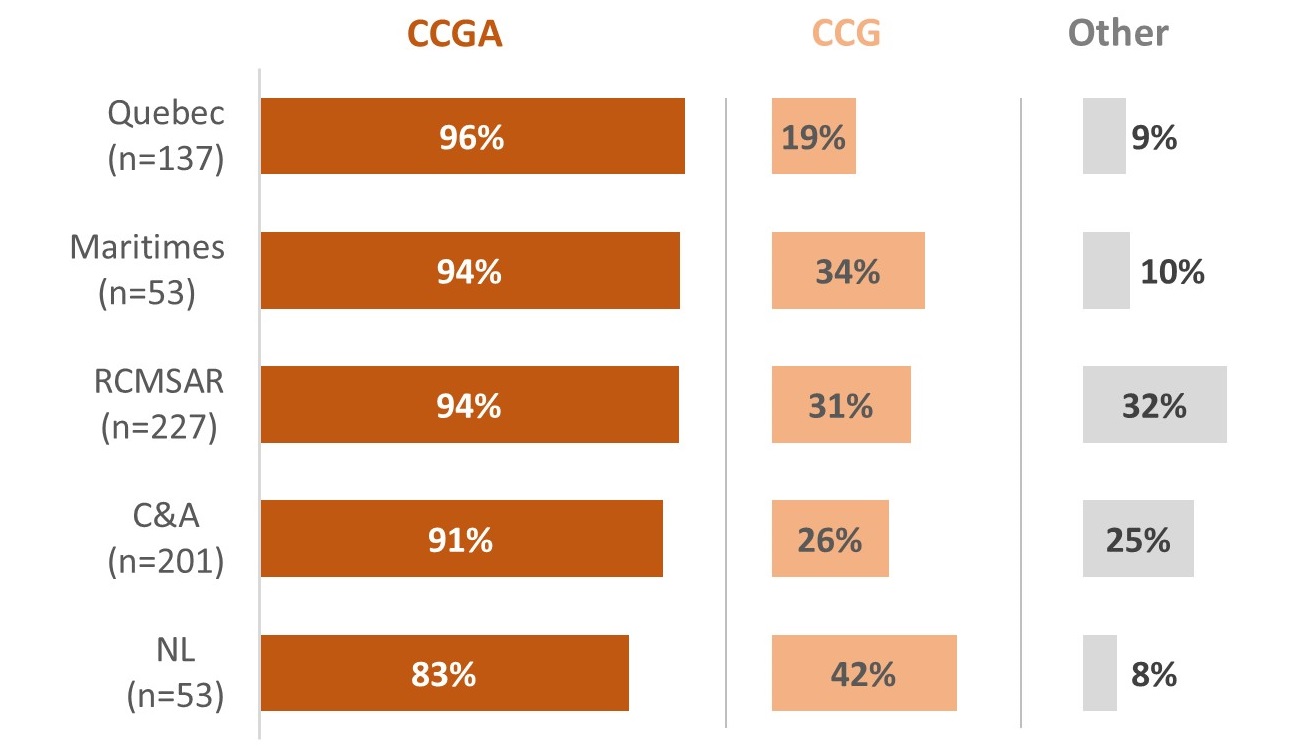
Source: CCGA member survey.
Description
The bar graph depicts the training source for CCGA survey respondents who took training in the past five years.
- In Quebec, 96% of CCGA survey respondents (n=137) received training through their own auxiliary, 19% through the Coast Guard and 9% took training through other sources.
- In Maritimes, 94% of CCGA survey respondents (n=53) received training through their own auxiliary, 34% through the Coast Guard and 10% took training through other sources.
- For RCMSAR, 94% of CCGA survey respondents (n=227) received training through their own auxiliary, 31% through the Coast Guard and 32% took training through other sources.
- In Central and Arctic, 91% of CCGA survey respondents (n=201) received training through their own auxiliary, 26% through the Coast Guard and 25% took training through other sources.
- In Newfoundland and Labrador, 83% of CCGA survey respondents (n=53) received training through their own auxiliary, 42% through the Coast Guard and 8% took training through other sources.
Note: percentages do not add to 100% because respondents were able to select more than one response.
Views on training received by Auxiliary members
CCGA member survey respondents were generally positive about their experience with training. The majority agreed that their auxiliary supports them in meeting training requirements and standards (89%, or 394 of 443). In addition, over three-quarters of respondents agreed that the training was easy to access (79%, or 600 of 758), was useful (96%, or 728 of 758), and prepared them to respond to maritime SAR incidents (94%, 713 of 758) (see Figure 17 below). These results were consistent across the regions, with no noteworthy differences.
The biggest issue related to training identified in the CCGA members survey was the availability of training. While 85% (644 of 758) of members who responded to the survey agreed that training was available, 15% (114 or 759) were neutral or disagreed that needed training was available. Respondents in C&A region were less in agreement on this, as 76% (152 of 200) agreed that needed training was available and 24% (48 of 200) were neutral or disagreed.
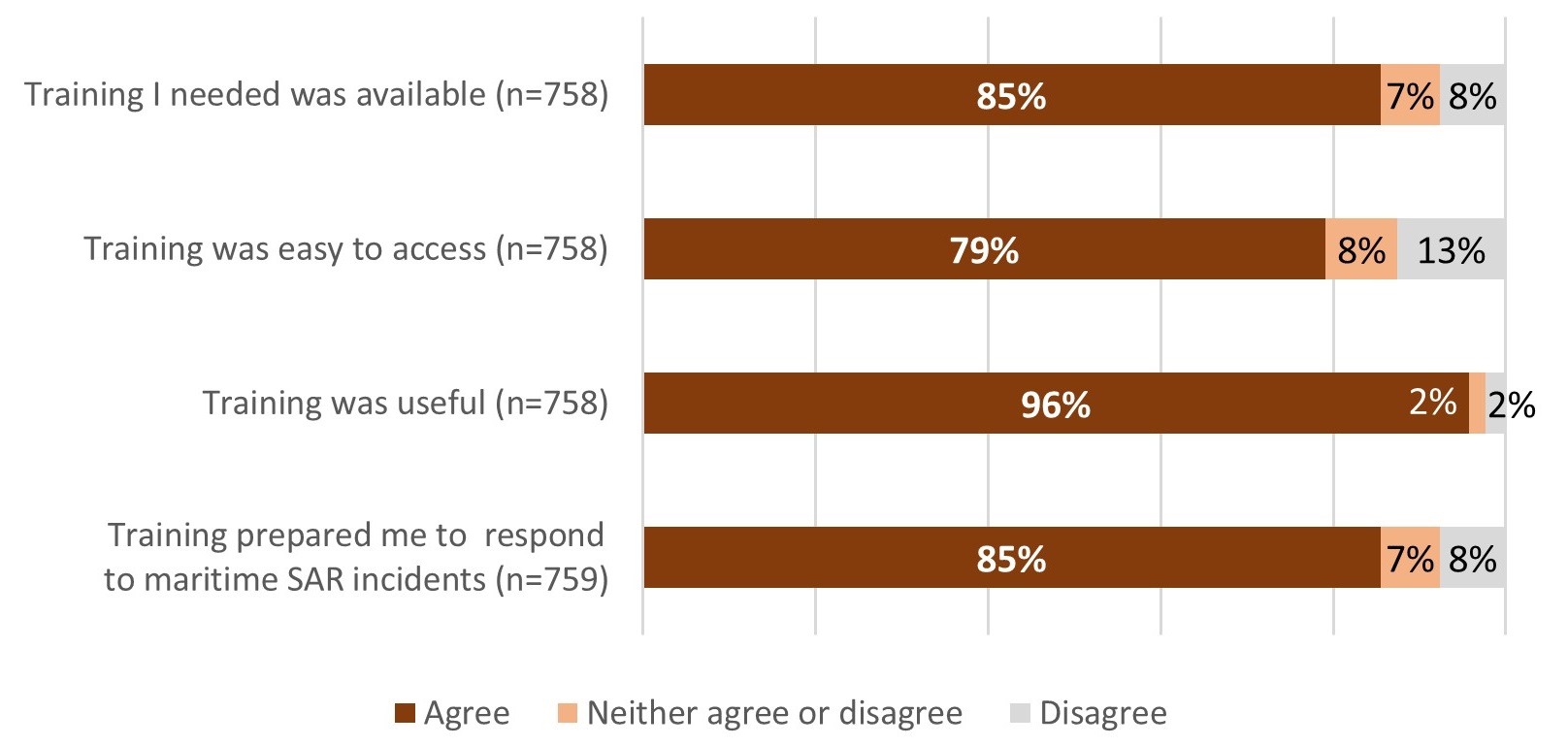
Source: CCGA member survey.
Description
The bar graph depicts the views of CCGA member survey respondents on the availability and usefulness of search and rescue training taken in the past five years.
- In response to the statement, “The training that I needed was available” (n=758): 85% of CCGA member survey respondents agreed, 7% neither agreed nor disagreed, and 8% disagreed.
- In response to the statement, “The training that I needed was easy to access” (n=758): 79% of CCGA member survey respondents agreed, 8% neither agreed nor disagreed, and 13% disagreed.
- In response to the statement, “The training that I took was useful” (n=758): 96% of CCGA member survey respondents agreed, 2% neither agreed nor disagreed, and 2% disagreed.
- In response to the statement, “The training prepared me to respond to maritime search and rescue incidents” (n=759): 94% of CCGA member survey respondents agreed, 4% neither agreed nor disagreed, and 2% disagreed.
Note: Responses for somewhat agree and strongly agree and somewhat disagree and disagree were combined.
Seventy-six percent of 132 CCGA director survey respondents somewhat agreed or strongly agreed that members have the training they need.
Challenges related to training.
While the majority of CCGA directors who responded to the survey agreed that members in their area have the training needed, more than half signaled challenges with respect to training, which suggests that even if they are meeting training needs, it requires a lot of effort to ensure that it happens.
Fifty-eight percent of 132 CCGA director survey respondents said that ensuring auxiliary members have the training needed is somewhat or quite a bit of a challenge.
Of note, is that virtually all directors in Quebec region (86%, or 27 of 28) who responded to the survey said that ensuring their members have the training that is needed is somewhat or quite a bit of a challenge.
Despite the fact that most regions did not use their planned training budget, the lack of resources (i.e., funding and people) was cited by interviewees as the main challenge to ensure that members maintain training in accordance with the national competency standards. Lack of resources was particularly mentioned as a challenge in C&A and NL regions, leading to out-of-pocket costs for CCGA members and/or hours of overtime for CCG regional staff.
There was insufficient data to support an accurate assessment of resource shortages (i.e., funding and people) related to training.
A number of other training challenges, not related to funding, were identified:
- Some courses are only available in big cities, which requires re-thinking the delivery modes that are used (e.g., sending instructors to communities). Some members specifically mentioned travelling to remote communities and the workload of CCG staff as factors limiting the availability of training.
- For personal reasons (e.g., personal life, other activities in the summer, other commitments), it is sometimes challenging for members to make themselves available for training.
- Anticipated change in Transport Canada’s regulatory frameworkFootnote 10 is another factor expected to increase the cost and the capacity requirements in some CCGA regions, which have developed their own small vessel operator proficiency training program to mitigate this risk.
- The COVID-19 pandemic (e.g., travel restrictions and lack of face-to-face sessions) had an impact on the training delivery and certification, particularly in the Arctic and in communities that recently joined the Auxiliary.
3.3.3 Effectiveness in responding to maritime search and rescue incidents
Findings: The Canadian Coast Guard Auxiliary is effective in responding to maritime SAR incidents. It is involved in almost one-quarter of overall incidents and maintains levels of service comparable to the ones established for CCG primary SAR assets.
Measuring the effectiveness of the Canadian Coast Guard Auxiliary
The main objective of the CCG with regards to SAR is to save 100% of lives at risk when maritime incidents happen. At the departmental level, the effectiveness of the SAR program is systematically measured against several performance indicators, two of which apply to the auxiliaries: percent of maritime SAR responses to which the CCGA responded and percent of reported lives at risk in the maritime environment that were saved.
Percent of maritime SAR responses to which the Auxiliary responded
Since 2015-16, the CCGA has responded to 24% of all maritime SAR taskings, exceeding the target of 20% each year. Furthermore, CCGA units have participated in 23% of distress taskings (e.g., M1 and M2 class). Figure 18 below presents the regional values of this indicator.

Source: CCG operational data.
Description
The stacked bar chart illustrates the percent distribution of all maritime SAR taskings, by CCGA region and by respondent category (2015-16 to 2019-20)
- On the West Coast, the CCGA was involved in 32% of all maritime SAR taskings, the CCG in 63% and other respondents in 5%.
- In Quebec, the CCGA was involved in 24% of all maritime SAR taskings, the CCG in 33% and other respondents in 43%.
- In Maritimes regions, the CCGA was involved in 20% of all maritime SAR taskings, the CCG in 60% and other respondents in 20%.
- In Newfoundland and Labrador, the CCGA was involved in 20% of all maritime SAR taskings, the CCG in 43% and other respondents in 37%.
- In the Central and Arctic region, the CCGA was involved in 17% of all maritime SAR taskings, the CCG in 39% and other respondents in 43%.
CCG SAR Program Performance Indicators
- Percent of maritime SAR responses to which the Canadian Coast Guard Auxiliary responded (Target: 20%).
- Percent of search and rescue responses that meet established standardsFootnote 13 (Target: ≥99%).
- Percent of reported lives at risk in the maritime environment that were saved (Target: >90%).
- Number of lifeboat stations built to increase the Coast Guard's search and rescue capacity(Target: 6).
- Number of SAR areas reviewed using risk-based analysis of maritime SAR delivery (RAMSARD) methodology each year (ongoing)(Target: 6 per year).
Source: DFO-CCG Performance Information Profiles (July 2021).
CCG levels of service, CCGA reaction time and duration of CCGA missions
The CCG’s primary maritime SAR assets are on stand-by 24 hours a day, 7 days a week, all year. As per the reaction time standards, they are expected to depart from the station within 30 minutes or less from being tasked, 99% of the time. Most CCGA units (with some exceptions, mostly on the West Coast) do not have 24/7 crews and, as volunteers, they are not subject to the same standard for timely response. Nonetheless, the evaluation examined the reaction times of tasked CCGA units. The average duration of maritime missions was also calculated to illustrate different maritime operational environments of CCGA regions. The missions of NL region are almost three times longer than the average duration of the other four regions (see Figure 19 below).
Percent of reported lives at risk in the maritime environment that were saved
The results achieved by CCGA and CCG on this performance indicator are the same: saving 98% of reported lives at risk in the maritime environment. The performance target of 90% or more was exceeded in each CCGA region, in each of the last five years. Figure 19 below presents the regional values of this indicator over the five-year period.
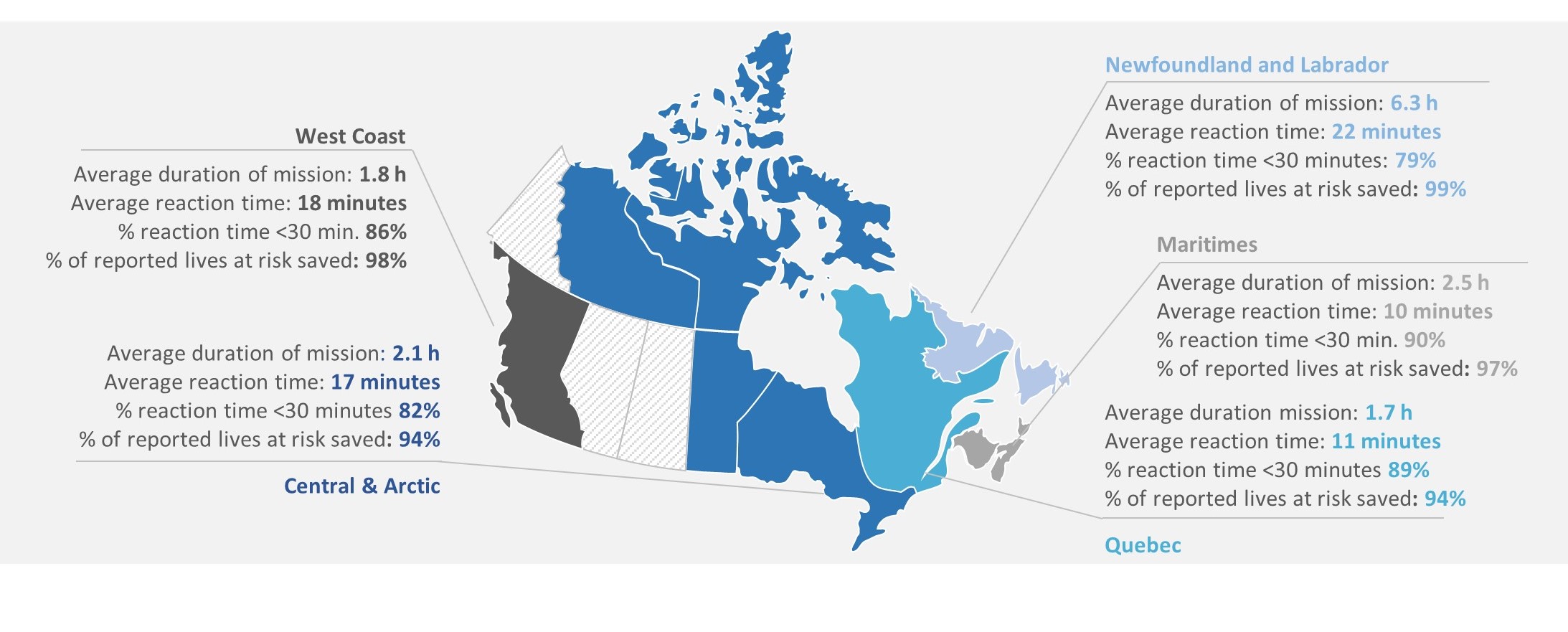
Source: CCG operational data.
Description
The figure shows a map of Canada showing key effectiveness indicators for the CCGA, by region (2015-16 to 2019-20)
For the West Coast
- Average duration of mission: 1.8 hours
- Average reaction time: 18 minutes
- % reaction time under 30 minutes: 86%
- % of reported lives at risk saved: 98%
For Central & Arctic
- Average duration of mission: 2.1 hours
- Average reaction time: 17 minutes
- % reaction time under 30 minutes: 82%
- % of reported lives at risk saved: 94%
For Newfoundland and Labrador
- Average duration of mission: 6.3 hours
- Average reaction time: 22 minutes
- % reaction time under 30 minutes: 79%
- % of reported lives at risk saved: 99%
For Maritimes
- Average duration of mission: 2.5 hours
- Average reaction time: 10 minutes
- % reaction time under 30 minutes: 90%
- % of reported lives at risk saved: 97%
For Quebec
- Average duration mission: 1.7 hours
- Average reaction time: 11 minutes
- % reaction time under 30 minutes: 89%
- % of reported lives at risk saved: 94%
On average, between 2015-16 and 2019-20:
- CCGA units departed for the incident location within 30 minutes or less, 87% of the time.
- The CCGA was on the water, on average, within 15 minutes of being tasked. The average reaction time of CCG units was the same during this period.
- The average duration of a SAR mission to which the CCGA responded was 2.7 hours.
The CCGA saved 1,758 lives at risk in Canadian waters during this period.
3.3.4 Contribution of the Indigenous community boat volunteer program to maritime search and rescue
Findings: The Indigenous Community Boat Volunteer pilot program has increased the number of Indigenous communities participating in the Canadian Coast Guard Auxiliary, particularly in the Arctic; has increased the capacity of some communities to participate in maritime search and rescue; and has had a positive impact on the relationship between the CCG and Indigenous communities.
Description of the programFootnote 14
The Indigenous Community Boat Volunteer (ICBV) pilot program is a grant and contribution program established as a pilot in 2016. It continued under OPP in 2017-18 and was planned to sunset in 2020-21 but was extended for one additional year.
The ICBV program provides funding to Indigenous communities to purchase a search and rescue capable boat and/or associated equipment with the objective of strengthening the capacity of Indigenous communities to join the auxiliary or enhance their existing membership in a regional CCGA. The annual ICBV program application process is initiated through CCG regions. Interested communities complete an application package, including letters of support from both the First Nations band and the regional CCGA. A national committee reviews the applications using an assessment protocol to assign a score to each application. Community participation in the Auxiliary is a mandatory condition for receiving support from the ICBV program.
Support provided by the Auxiliary to Indigenous communities participating in the ICBV program
The CCGA provides support to Indigenous communities that are participating in the ICBV program, including outreach, administrative assistance for the application process, technical expertise for identifying the right boat/equipment, and training for community members. Overall, the support provided to Indigenous communities participating in the ICBV program by the different regional CCGA organizations is considered beneficial.
Participation of Indigenous communities in the program
Between 2017-18 and 2020-21, the ICBV program funded 35 communities through 42 projects, totaling $10M. The annual funding provided to communities to purchase boats and equipment has increased over the four-year period, from $1M in 2017-18 to $3.5 in 2020-21 (see Figure 20 below).

Description
This figure depicts the ICBV program funding (in millions) and projects for the period 2017-18 to 2020-21.
- In 2017-18: the ICBV funded 4 projects for $1.0 million.
- In 2018-19: the ICBV funded 14 projects for $2.7 million.
- In 2019-20: the ICBV funded 10 projects for $2.7 million.
- In 2020-21: the ICBV funded 14 projects for $3.5 million.
The number of applicants far exceeds the available funding. In 2020-21, funding was available for only 67% of communities that submitted applications (i.e., 14 communities). To address this, in the fifth year of the program, a more targeted approach was adopted with the goal of first reaching to potential applicants in areas with known gaps in SAR capacity.
Impact of the program on the capacity of Indigenous communities to respond
The evaluation confirmed that, even within the short period of its existence, the ICBV program contributed to marine safety, overall, by enhancing the participation of Indigenous communities in the auxiliary.
In remote coastal areas, Indigenous communities are the first responders to marine SAR incidents in their waters. Interviewees said that the program increases their capacity to respond by having more vessels on the water. As a result of the ICBV program and upon completing the projects, 33 new SAR vessels will be added to the fleet in the six CCGA regions. To date, 24 vessels have already been received by Indigenous communities. Furthermore, 18 new communities are now part of the CCGA, and 17 communities that previously had auxiliary units, are better equipped to participate in missions. The new units provide additional capacity for SAR, particularly in remote, coastal areas where communities can be hard-to-access. This improves the overall SAR system, particularly in the Arctic, where nine new units became members of the CCGA. A map in Appendix B depicts the locations of the communities where ICBV program funding made it possible to address SAR gaps.
It is worth mentioning that, through the support of both the CCG and the CCGA to ICBV recipients, more Indigenous volunteers have received formal training. This training, augmented with the local and traditional knowledge, increases the overall preparedness of the units. In addition, communities feel both proud and empowered because they can use safe and up-to-date, capable vessels and better participate in SAR activities.
Impact on relationships
Overall, the impact of the ICBV program has been very positive. Many interviewees mentioned that it had been a big steppingstone towards much needed capacity building in their communities. The program has also facilitated the strengthening of relationships between the CCG and Indigenous communities, as it builds trust between the multiple SAR stakeholders (e.g., First Nations, the CCG, the CCGA) that work and train together.
Program improvements / sustainability of the program
Many interviewees expressed appreciation regarding the ICBV program and thought that its contribution to maritime SAR should continue. However, they also shared concerns about the long-term sustainability of the program. While there is limited data for the first three years of the ICBV program to assess the demand for the program, data from 2020-21 does show that the demand was larger than available funding. Until 2020-21 the ICBV program was able to increase its budget, for example, by re-allocation of funding from ten other CCG programs, and the one-year extension under OPP. Nonetheless, it was noted that ensuring appropriate funding in the future would be essential, in particular, to address lifecycle costs and plans for the vessels.
Additional details on potential areas of improvement of the ICBV program are provided in Appendix B.
4.0 Conclusions and considerations
4.1. Conclusions
Overall, the CCGA contributes significant volunteer capacity to the national maritime SAR system as a partner of the CCG. The Auxiliary addresses a continued need for maritime search and rescue response, in an effective and efficient way.
Need for the CCGA
The Auxiliary’s participation accounts for about 24% of SAR response missions in Canadian waters each year. Between 2015-16 and 2019-20, the CCGA responded to 8,027 maritime SAR calls and delivered 17,000 hours of SAR operations. In some areas, the Auxiliary complements and assists permanent CCG SAR resources. In remote areas where permanent CCG assets are not available, the Auxiliary helps to improve service coverage. The need for CCGA’s ongoing participation in maritime response will continue, given emerging risks, such as those related to climate change and increased maritime activity in the north.
Role of the CCGA
The current role of the CCGA in the maritime search and rescue system is appropriate and aligned with its mandate and current levels of contribution funding. While most activities undertaken by auxiliary organizations are directly related to maritime SAR safety and operations, some units are occasionally involved in other activities, such as public education. Under OPP, there have been efforts in some regions to explore the feasibility of gradually expanding the role of the CCGA to include basic environmental response.
Utilization of resources
The CCG is the main source of funds for the operation of the Auxiliary. The regional CCGA organizations fulfill the requirements from the contribution agreements with respect to costs, planning and reporting; and have in place effective internal guidance, management practices and controls. Since 2016-17, core contribution funding has not changed significantly, however, some supplementary funding was provided to some regions to undertake activities funded through OPP.
Capacity and readiness
Overall, CCGA regional organizations are well-prepared to respond to maritime SAR incidents as measured by the availability of members trained to the Auxiliary’s national standards, and vessels and equipment fit for service. CCGA regions consider, as their key priorities, preparedness, capacity building and training support for members to achieve required competencies and skills and progress beyond the basic requirements. More than 50% of the total CCG funding is used for preparedness and capacity building; and, according to CCGA members, overall, training is available, accessible and useful.
Performance
The CCGA is effective in responding to maritime SAR incidents. Between 2015-16 and 2019-20, the CCGA saved almost 1,800 lives at risk in Canadian waters and was involved in almost one quarter of the overall incidents, including 23% of distress taskings (e.g., M1 and M2 class). Across Auxiliary regions, CCGA units responded to between one-third and three-quarters of the taskings responded by CCG assets. In addition, CCGA volunteer resources have maintained levels of service comparable to the ones established for CCG primary SAR assets.
Furthermore, the ICBV program, with the support provided by the CCGA, has increased the capacity of some communities to participate in maritime search and rescue; and has had a positive impact on the relationship between the CCG and Indigenous communities.
4.2 Considerations for future programming
While the findings from the evaluation did not result in any recommendations, the report includes considerations for future programming.
Core funding
Overall, the core funding on which most CCGA regions exclusively rely to support their ongoing activities and business, remained at the levels close to the average core funding received 10-15 years ago, or about $1.0M. Consequently, the core funding currently does not cover all the costs that the auxiliaries incur, and this impacts the ability of the CCGA to maintain vessels, equipment, and training available and up to the Auxiliary’s national standards. While the supplementary (i.e., OPP) funding helps to some extent with some pressures in some regions, it does not offset negative impacts of factors that are out of the Auxiliary’s control, such as inflation and rising costs (e.g., insurance, fuel, material).
Ensuring sustainability
There are challenges that can have an impact on the ability of the CCGA to sustain the capacity and preparedness of the units (e.g., retaining sufficient membership and access to vessels, ensuring that equipment meets standards, delivery of essential training). These challenges are related to internal and external factors, including but not limited to funding (e.g., remoteness, income, cultural differences, personal life).
Data and information limitations
While the CCG obtains sufficient information on funding distribution for accountability and oversight, there are limitations to assessing the full costs for the Auxiliary to participate in the national SAR system. Auxiliaries work as independent organizations, and the CCG does not have the mandate nor the capacity to oversee all aspects of their business and activities. Without the full picture of funding sources and shortages, the CCG is limited in identifying gaps in service or capacity and in planning appropriate measures, including increased funding, to address them.
CCGA future role
There may be opportunities to utilize the auxiliaries more, for example, by expanding the role of the CCGA in some regions, particularly for environmental response. Currently, there are limitations to defining all parameters of what would be needed should new activities be added to the CCGA role, and to assessing the anticipated value-added. An expanded CCGA role would require changes to the current policy and legal framework under which the auxiliary operates, as well as to the training and the funding, and not all regions and volunteers have the capacity or willingness to take on additional tasks at this time.
CCG-CCGA partnership and communication
The CCG's support to auxiliaries is valued and appreciated. Nonetheless, there seems to be a desire for further improvements in the partnership between the CCG and the CCGA by increasing two-way communication and having open discussion on aspects of coordination and standardization (e.g., processes and training).
5.0 Appendices
Appendix A – Detailed evaluation methodology
The evaluation was conducted using an evaluation framework, which included the evaluation questions summarized in section 1.3, as well as indicators. Data was collected through the following lines of evidence, which were triangulated to develop the overall findings.
Survey
The purpose of the survey was to gain a better understanding of the perceptions and opinions of individuals who have a significant role or experience in the delivery of CCGA activities. A survey with CCGA volunteers provided an understanding of their perceptions of preparedness and training. They also expressed their perspective on their experience as members and the challenges they might face.
An online survey was administered to CCGA volunteers. The survey was administered between October 29 and November 26, 2021, and the responses were used to triangulate findings from other lines of evidence.
A total of 881 CCGA members out of 3,902 responded to the CCGA survey for a survey response rate of 23%. Of those respondents, 134 members who also head a management position (ranging from a station leader to a zone/region director) answered specific questions related to the challenges of SAR operations in their responsible areas.
Fifty-five percent of survey respondents were from two regions [28% were from the Pacific Region (n=248) and 27% from the Central and Arctic Region (n=234)]. The remaining 45% came from Quebec, Maritimes, and Newfoundland and Labrador Regions (n=399). In consultation with the Coastal Nations Coast Guard Auxiliary management, it was agreed that its members were not included in this survey, since the organization is newly formed.
Survey data has a 2.91% margin of error at a 95% confidence level, which means that the data will be above or below 3% points over the real population value 95% of the time.
Limitations: Only a small number of members with a management position in the Newfoundland and Labrador Region responded to the survey. For that reason, data for the Newfoundland and Labrador region is not included in the regional breakdown related to CCGA director-level questions. In consultation with the Coastal Nations CGA (CN CGA) management, CN CGA members were not included in this survey since the organization was newly formed. To mitigate that limitation, the evaluation division conducted interviews with CN CGA representatives and asked them additional questions about SAR preparedness and training.
Case Study
The Evaluation division analyzed the Indigenous Community Boat Volunteer program administrative and financial data, reviewed key CCG documents and conducted 17 interviews with program representatives and ICBV recipients.
Document Review
The evaluation team reviewed CCG, CCGA and external documents to understand the context and background of the SAR program and to assess the general relevance, effectiveness and governance of the CCGA. This included SAR program documentation, contribution agreements, CCGA business plans, legislation, and external reports.
Interviews
The evaluation team conducted 30 interviews with 33 individuals, including 20 CCG senior management and staff members, and 13 CCGA representatives. Interviews were structured to discuss a range of questions related to program relevance, effectiveness, and utilization of resources.
Due to COVID-19 travel restrictions, the evaluation team was unable to meet with CCG senior management and staff members, and CCGA representatives in person and instead, interviews were conducted via teleconference.
Data Analysis
The evaluation conducted data analysis from three categories of data:
CCG Operational Taskings Data: Records from the JRCC SAR system of all SAR incidents, taskings and responding assets from April 1, 2015, till March 31, 2020, were provided by the CCG Operational Data team. Data was analyzed by incident class, by CCGA region, by fiscal year, and by category of respondents.
CCGA Administrative Data: Statistics on CCGA regions (e.g., members, vessels, units) were extracted from the annual insurance forms from 2016 to 2021 by the evaluation team. CCGA regions were asked to provide summary data on training, vessels and equipment.
CCGA Financial data: Data on planned and actual expenditures by core and supplementary funding, from 2016-17 to 2020-21, was extracted from the CCGA regions’ business plans and financial reports. Data on all sources of funding of the CCGA regions was extracted from the annual audit reports from 2015-16 to 2019-20.
Limitations: All CCGA regions were asked to validate and complement, if applicable, the administrative and financial data compiled by the evaluation team prior to the analysis. One region did not respond. Some regions provide limited data on training, vessels and equipment status; it did not allow for rigorous analysis of these aspects of capacity and preparedness of CCGA. Some limitations regarding the coherence of data are possible due to changes in the reporting templates and categories and different data sources being reported on different timeframes.
Appendix B – Indigenous Community Boat Volunteer program
Description of the program
The Indigenous Community-Boat Volunteer (ICBV) pilot program started as a four-year pilot under the World Class Tanker Safety System (WCTSS) initiative in 2016 for implementation south of 60o (non-Arctic). Its scope was re-focused to north of 60o (the Arctic) one year later, as part of the Oceans Protection Plan. The purpose of the program is to strengthen the capacity of coastal Arctic communities to safely participate in maritime search and rescue response activities within their locations and to enhance marine safety through membership in the CCGA. Prior to that, some Indigenous communities on the West Coast and in the Arctic were members of the Auxiliary but were not directly funded. Since 2017, ICBV funding allowed communities to purchase vessels and equipment that are required to be part of the Auxiliary. Eligible categories for the ICBV funding are aligned with the requirements for SAR vessels and equipment as defined by regulations under the Canada Shipping Act (2001), as well as with the requirements specific to the CCGA. The ICBV program also provides ongoing funding for the CCGA to support the new Auxiliary members that join as a result of the ICBV Program.
ICBV program application process
The ICBV application process starts with sending out information to CCG regions, which then send a callout to Indigenous communities through the regional Indigenous Engagement teams. Interested communities complete an application package, including letters of support from both the First Nations band and the regional CCGA. A national committee reviews the applications. The ranking scores are based considerations such as: existing support and capacity in the community to form an Auxiliary unit and to provide preventive and routine maintenance of the boat and equipment; or availability of a storage for a boat and equipment. Starting in 2020-21, alignment with SAR gaps is expected to be a criterion for assessing the applications for ICBV program funding.
Between 2017-18 and 2020-21, the ICBV program funded 42 projects, totaling $10,018,182. The annual funding provided to communities to purchase boats and equipment has continuously increased, and in 2020-21, it was close to $3.55M, an increase of 250% from the funding in 2017-18. The increase of the annual budget was possible due to the re-allocation of funding from ten other CCG programs. In 2021, the ICBV program was extended by one year, until March 2022.
The ICBV program funded 35 communities including 28 unique communities and seven communities that received additional funding (20%). On average, each project received $238,528, a relatively stable figure over the first four years of the program, and across regions except for Quebec, where only one community received funding so far.
Examples of eligible categories for ICBV funding
- SAR emergency response capable vessel
- Equipment (communications, safety and search and rescue)
- Repairs to an existing boat
- Boat shelter
- Boat and equipment upgrade
- Increased cost for boat or shipping cost
Contribution of the ICBV to the capacity of the CCGA regions
From 2017-18 to 2020-21, communities in all six regions of the CCGA received ICBV program funding, which allowed them to gain capacity and be active members of the respective regional auxiliary organizations.
As previously noted, there were a total of 42 ICBV funded projects for the four years of the program, in 35 indigenous communities. Seven projects were for additional funding to a previous recipient community. Furthermore, some of the projects did not include funding of a new boat; however, a few projects funded more than one boat in the same community. The distribution of funded communities and new boats are summarized in by CCGA region and by fiscal year in Figure 21 below.
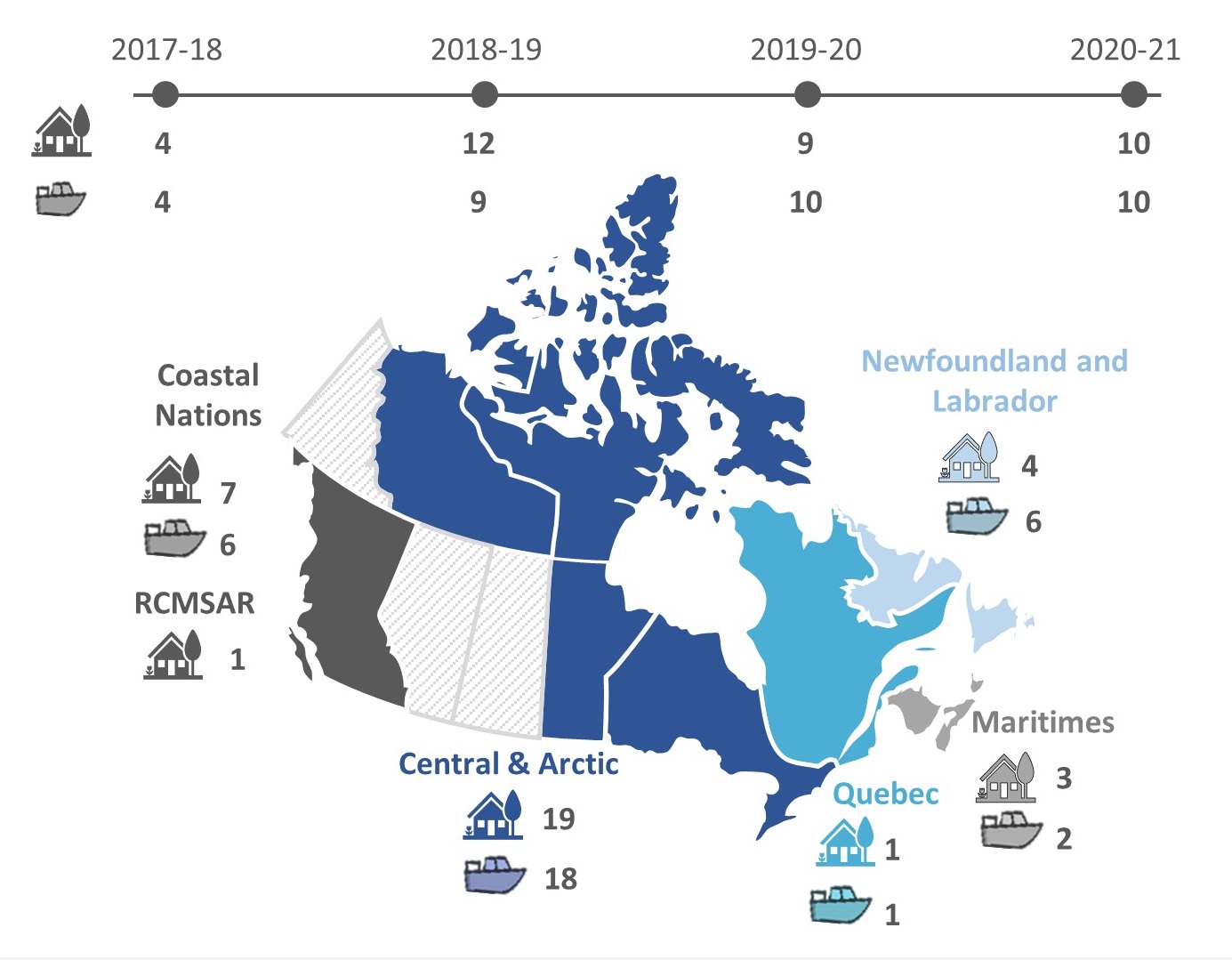
Description
This figure depicts the number of communities and new boats funded through the ICBV program, by fiscal year:
- In 2017-18: 4 communities and 4 new boats were funded through the ICBV program
- In 2018-19: 12 communities and 9 new boats were funded through the ICBV program
- In 2019-20: 9 communities and 10 new boats were funded through the ICBV program
- In 2020-21: 10 communities and 10 new boats were funded through the ICBV program
A map of Canada shows the number of communities and new boats funded through the ICBV program, by CCGA region.
- For the Coastal Nations: 7 communities and 6 new boats were funded through the ICBV program
- For RCMSAR: 1 community was funded through the ICBV program
- For the Central & Arctic region: 19 communities and 18 new boats were funded through the ICBV program
- For Quebec: 1 community and 1 new boat were funded through the ICBV program
- For the Maritimes: 3 communities and 2 new boats were funded through the ICBV program
- For Newfoundland and Labrador: 4 communities and 6 new boats were funded through the ICBV program
Role of the ICBV in the expansion of the CCGA in the Arctic
The Arctic geographic area where the ICBV is intended to contribute most with regards to enhancing the Auxiliary capacity cuts across five provinces and territories [NL, Northwest Territories (NWT), Nunavut (NU), Manitoba and Quebec], and three CCGA regions (C&A, NL, and Quebec). In the Arctic, the ICBV program supported the creation of 9 new Auxiliary units. As of 2021, 27 projects in 21 Arctic communities were funded, totaling more than $6 million, which included funding for 22 new boats (6 in NL, 4 in NWT, 11 in NU, 1 in Manitoba and 1 in Quebec).
The ICBV program contributed to improving service coverage in Arctic and non-Arctic areas, as shown on the map in Figure 22 below.
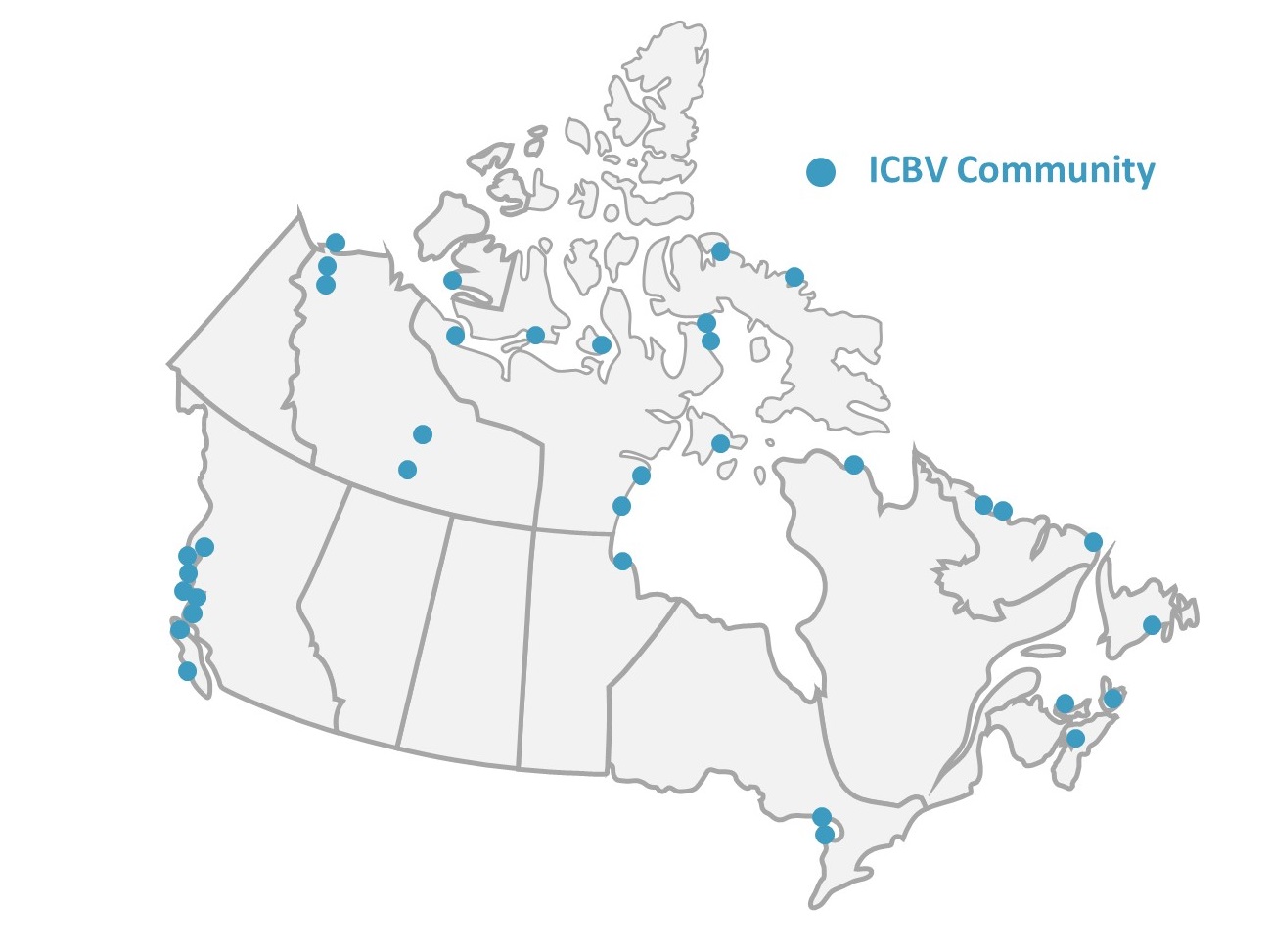
Description
A map of Canada showing the location of communities that have received a community boat through the ICBV program.
Impact of the program on the capacity of Indigenous communities to respond
Even though it is very early in the program to assess its contribution to marine safety, overall, the evaluation found that the funding provided to communities through the ICBV program will increase their capacity to respond upon completion of the projects. In addition, the formal training of new members provided in connection to the ICBV program, augmented with the local and traditional knowledge in the communities, contributed to the improvement of marine safety in their locations.
Impact on relationships
Overall, the impact of the ICBV program has been very positive on the relationship between the Indigenous communities and the CCG. Many interviewees expressed appreciation about the program as an important start to relationships with many communities. The program also facilitates the strengthening of relationships between Indigenous communities and the CCG, as it builds trust between the multiple SAR stakeholders (e.g., First Nations, the CCG, the CCGA) that work and train together.
Program sustainability and potential areas for improvement
For many interviewees, the main concern is the long-term sustainability of the program. They believe that it is essential to ensure appropriate funding in the future. Firstly, an increase in the funding would assure that more communities meeting the application criteria could be supported. Secondly, many respondents mentioned the lack of forward-thinking related to maintenance and repairs of both boats and equipment that have been already funded. Lastly, additional funds for the regional Auxiliaries would be required to support the increased number of new units and auxiliary members joining as part of the ICBV program, for example for training and onboarding of the new volunteers.
The use of community boats for SAR-only activities seems to be another area of concern noted by interviewees. The ICBV program's scope is not necessarily reflective of indigenous communities' needs, as the eligible funding purposes are limited to procurement of a SAR-response capable vessel and/or vessel equipment, while some communities would rather have a multi-response/purpose vessel. Some respondents saw this limitation as a potential waste of resources and suggested expanding the scope to environmental response and maritime awareness, to allow Indigenous communities to be self-sufficient. In contrast, others mentioned that the scope would be hard to change due to the requirement to grant funding only under the condition to become part of the Auxiliary, while the Auxiliary’s current mandate is exclusively SAR-specific.
Finally, the timing and transparency of the application process were noted as potential areas for improvement. Interviewees said that it was not always clear how communities were selected. The rankings could potentially be skewed if no clear criteria beyond the completed application package are followed and given that the selection process did not necessarily align with SAR needs and risks.
While the CCG considered the possibility for targeted engagement with Indigenous communities in locations with identified SAR gaps, in the first years of the ICBV program, it was challenging to determine the priority target areas due to limited availability of completed RAMSARD reports and reliable data on SAR incidents. The ICBV program has drawn lessons from it and adopted a targeted approach in the selection process for the year 2021-22.
RAMSARD is a risk-based methodology assisting CCG in proactively identifying SAR areas with new and emerging marine risks, and in evaluating more systematically the maritime SAR delivery in Canada. Although developed in 2013, the national implementation of RAMSARD has been delayed until 2016-17, due to lack of dedicated resources.
- Date modified: